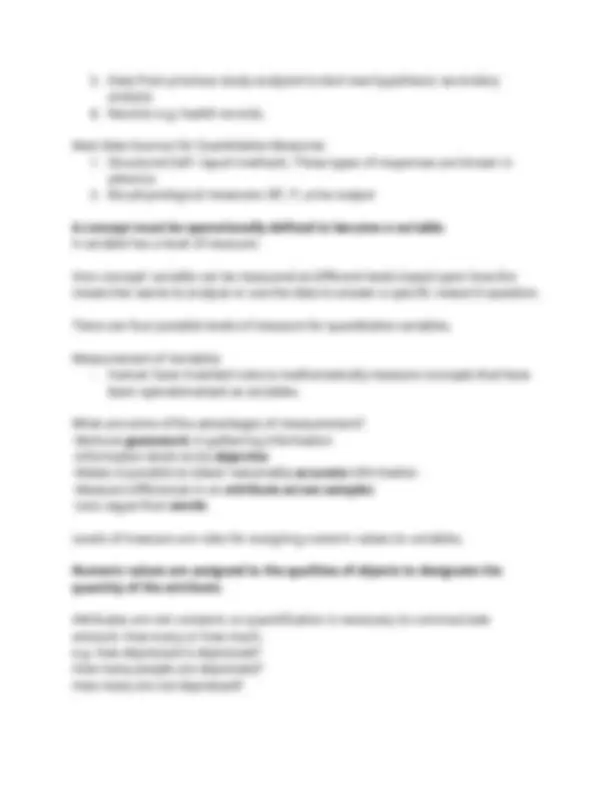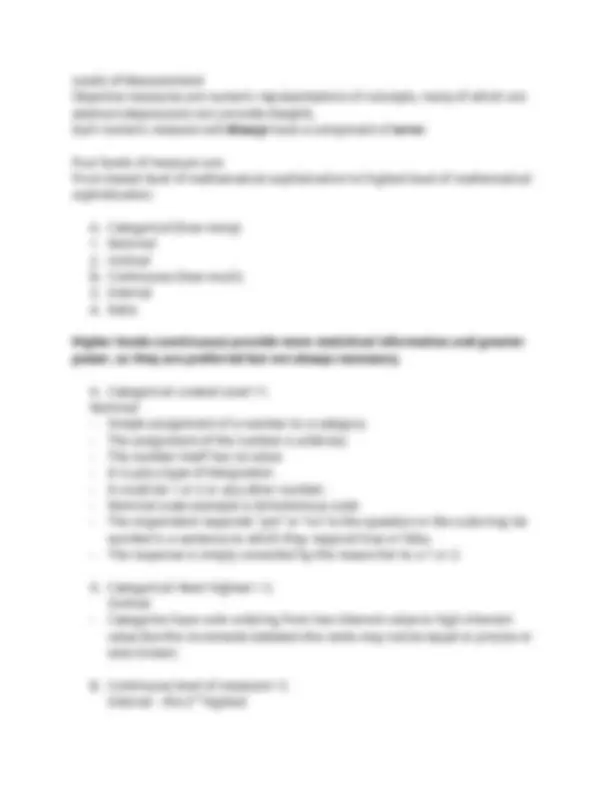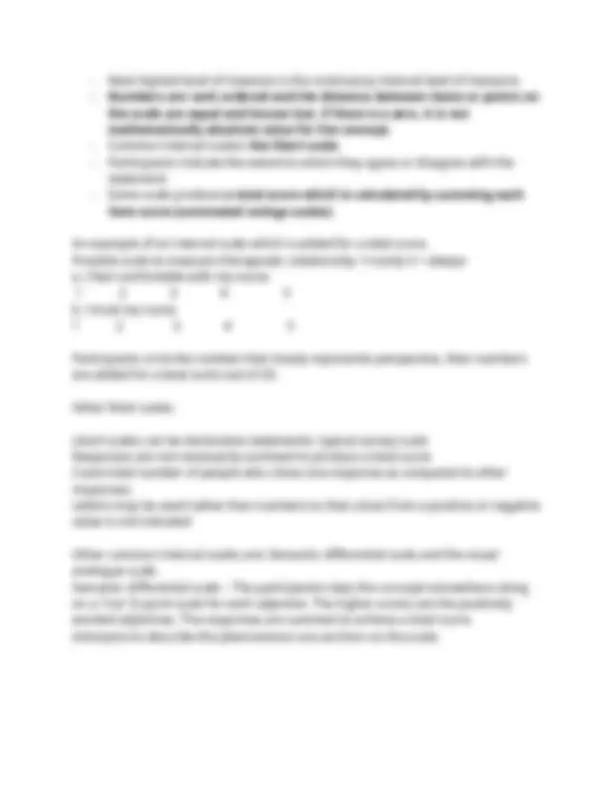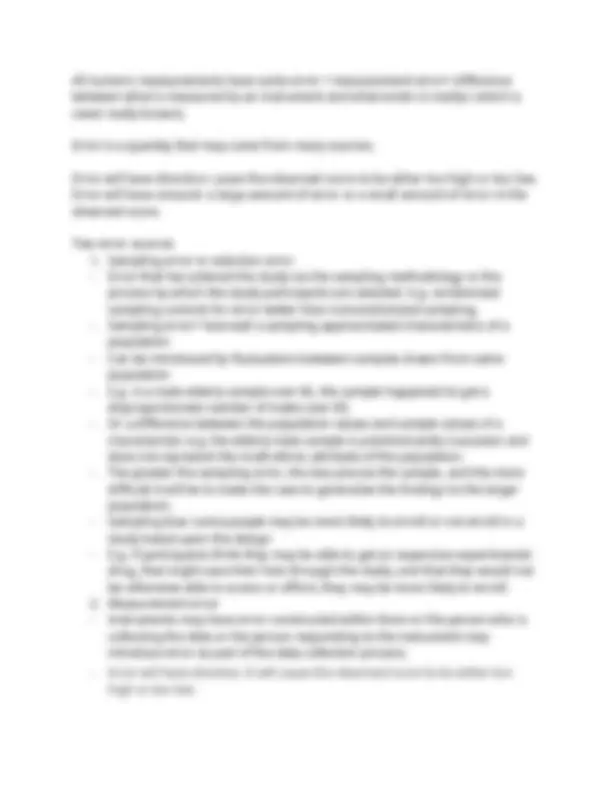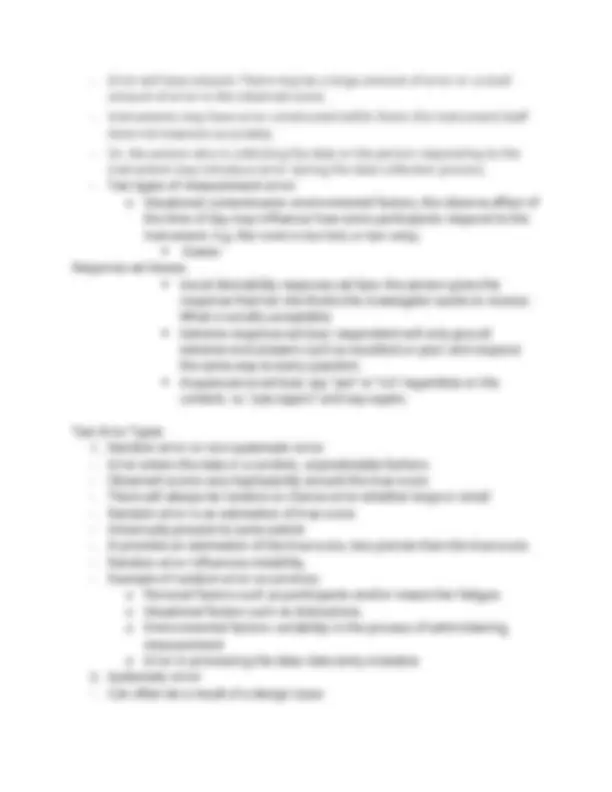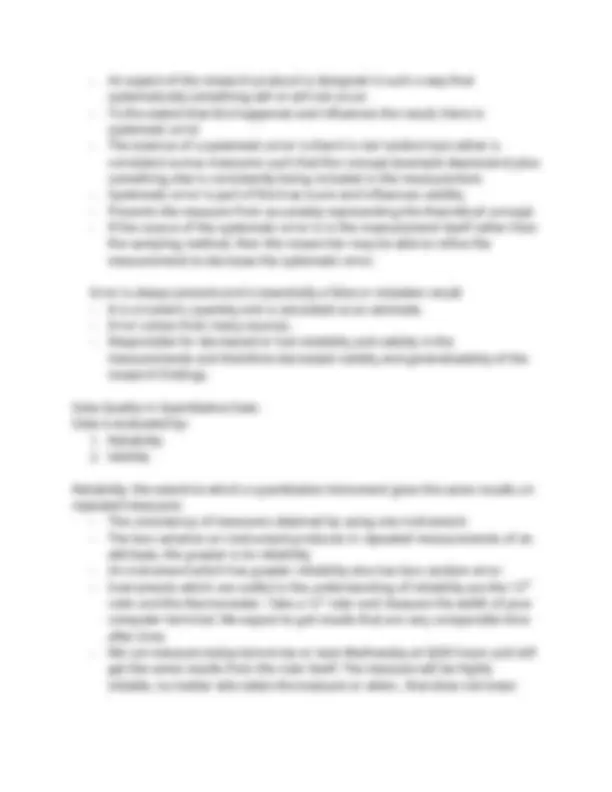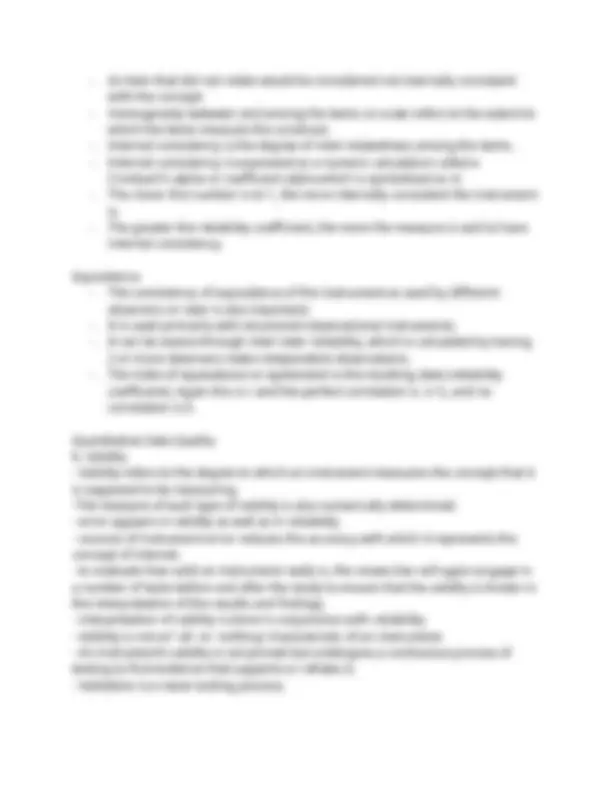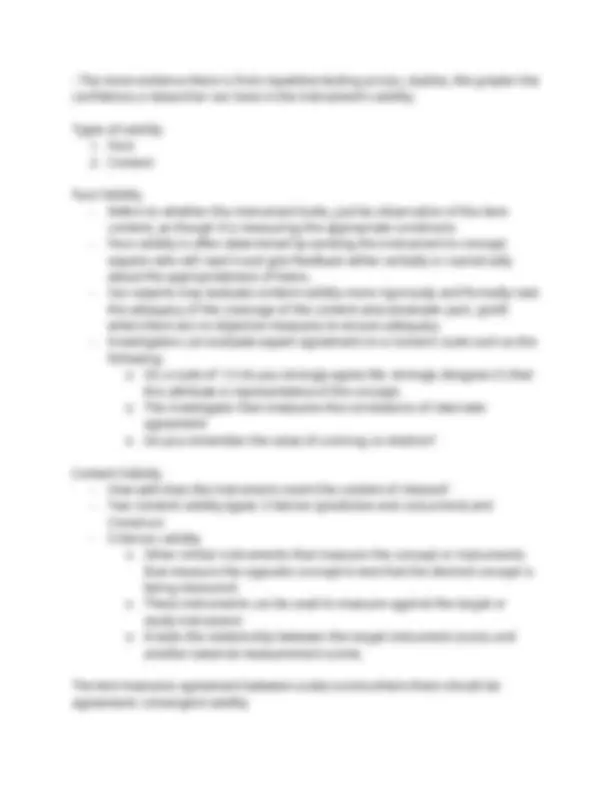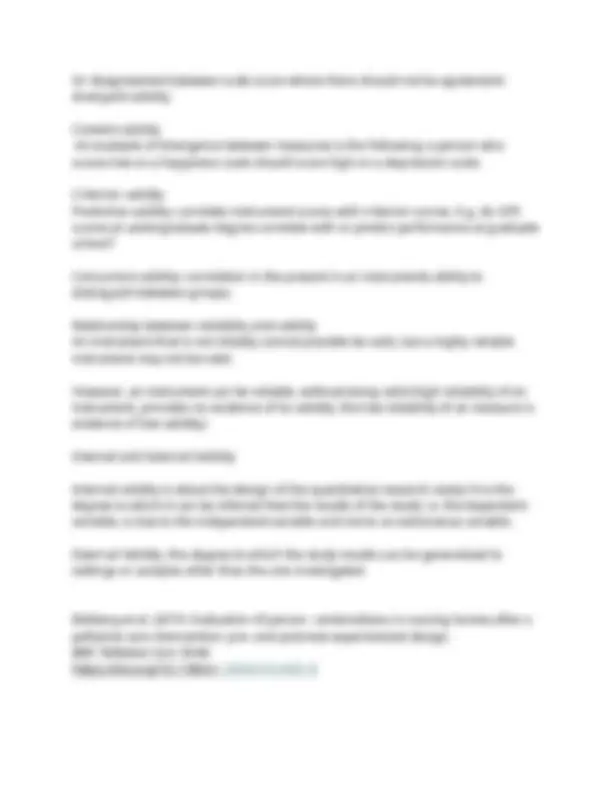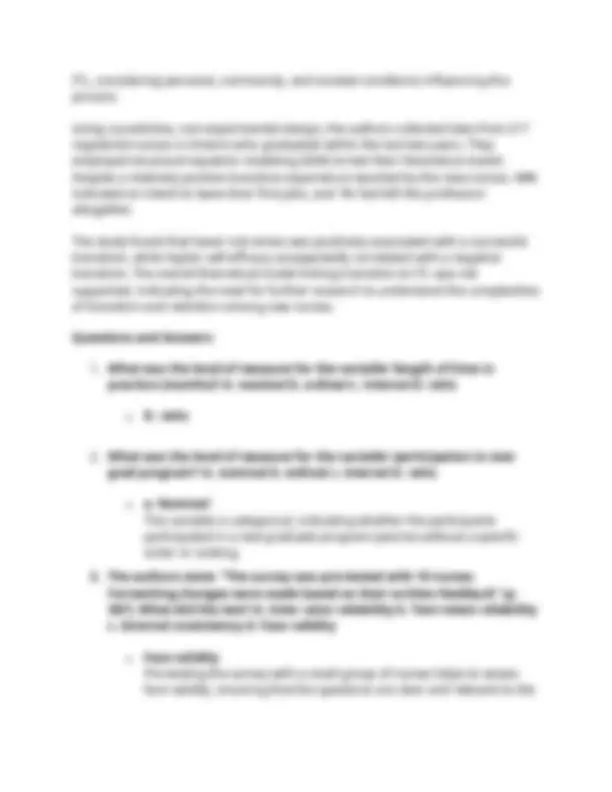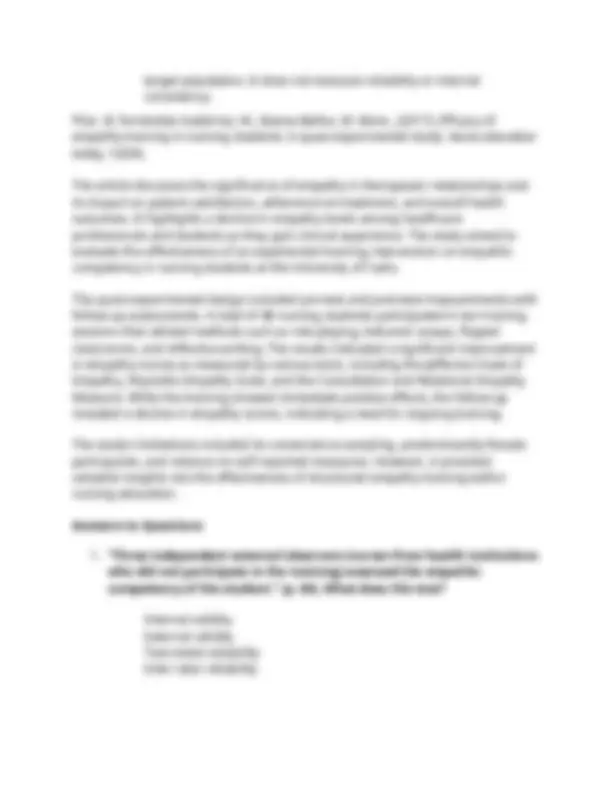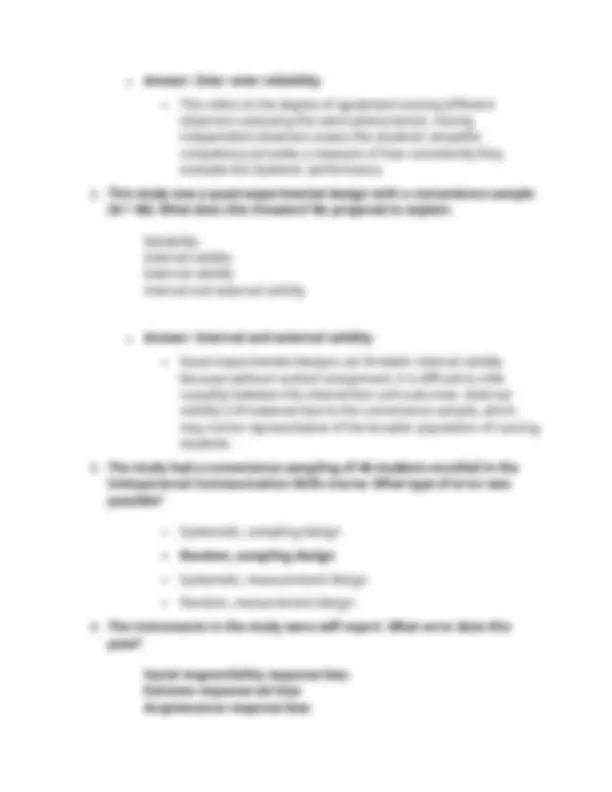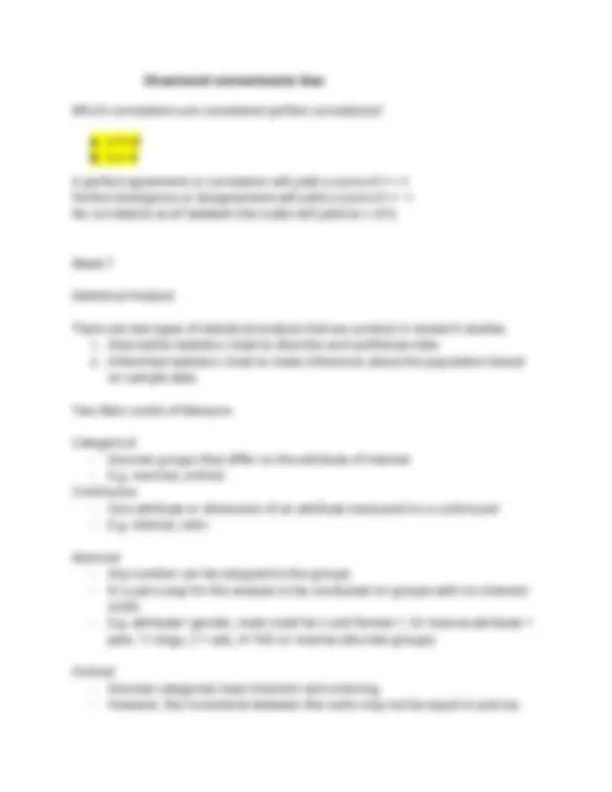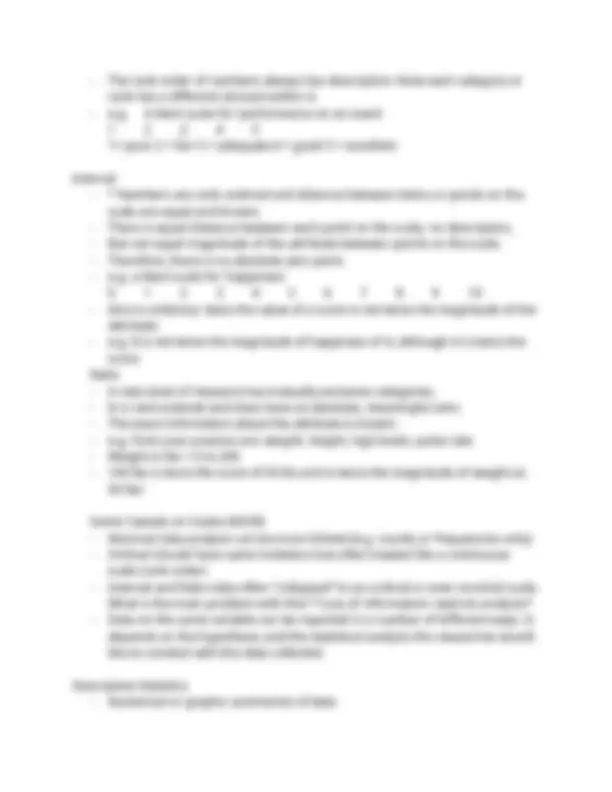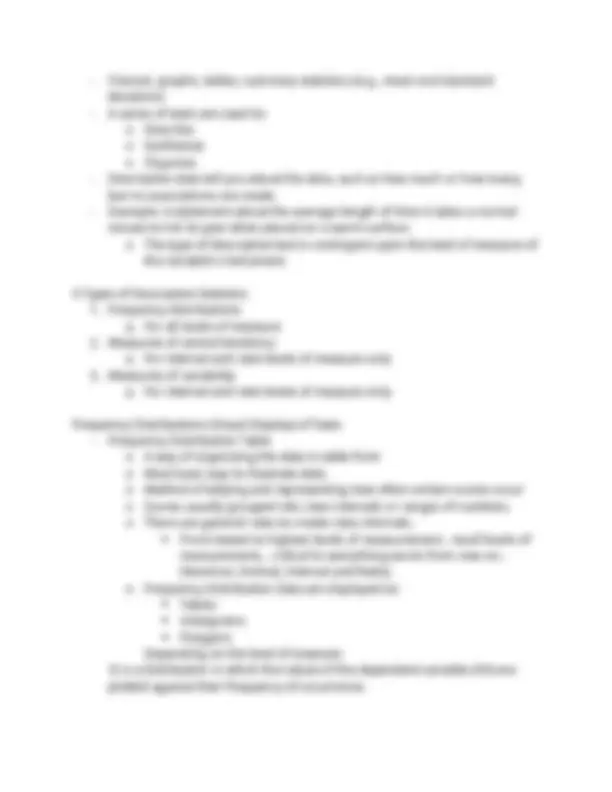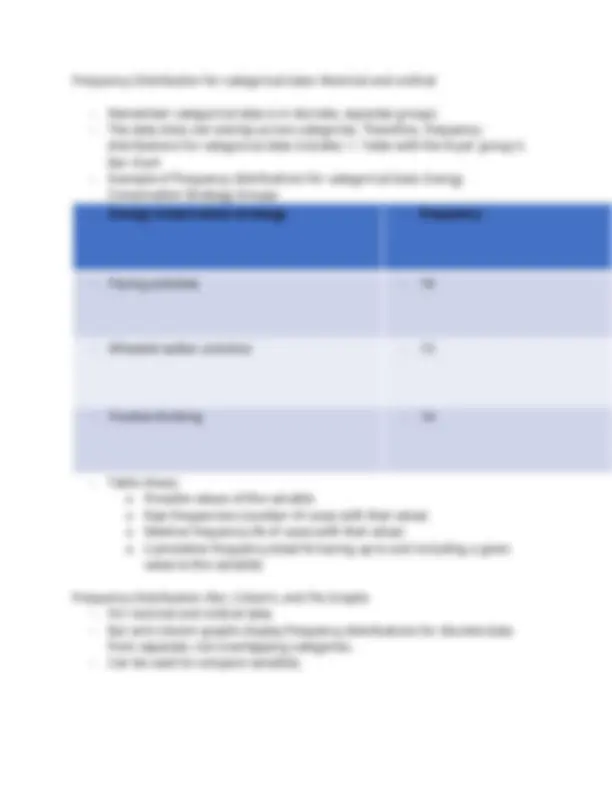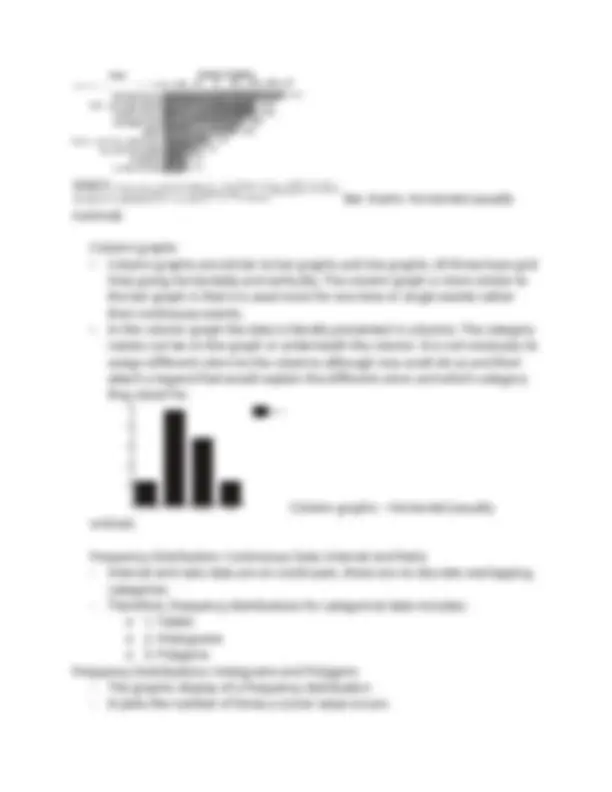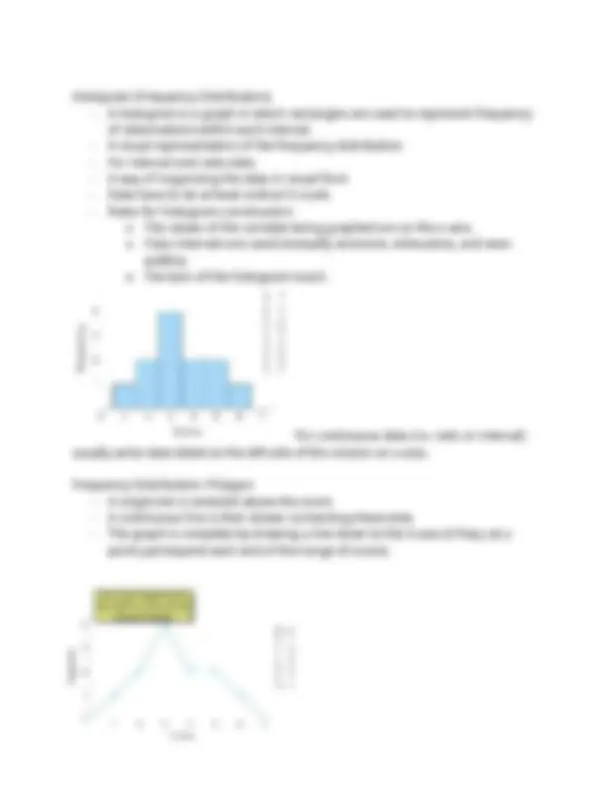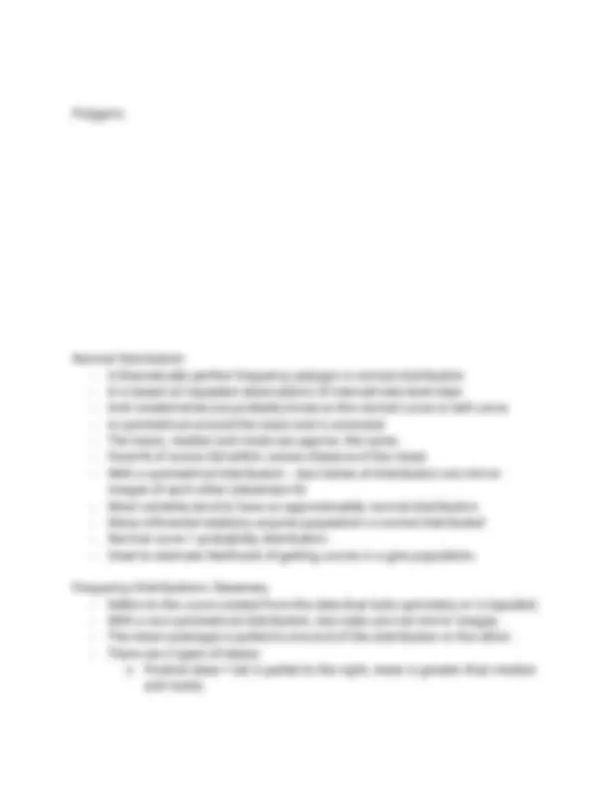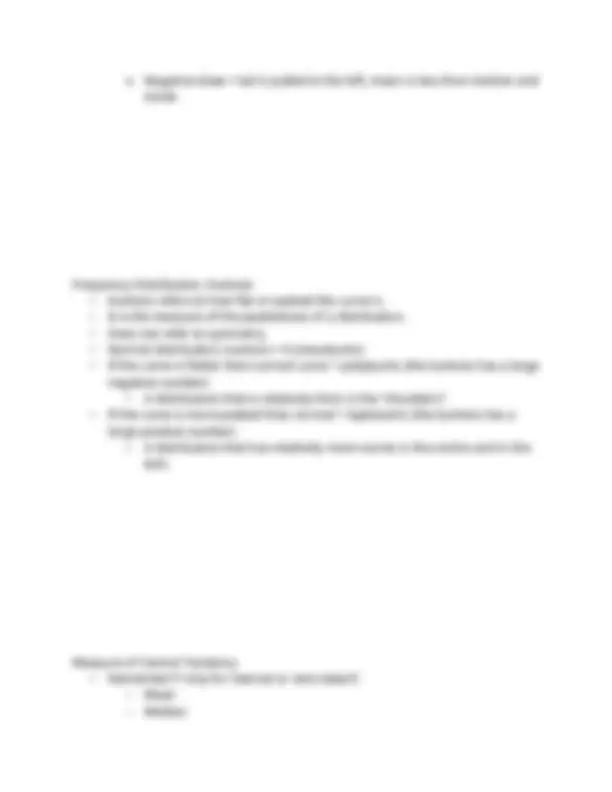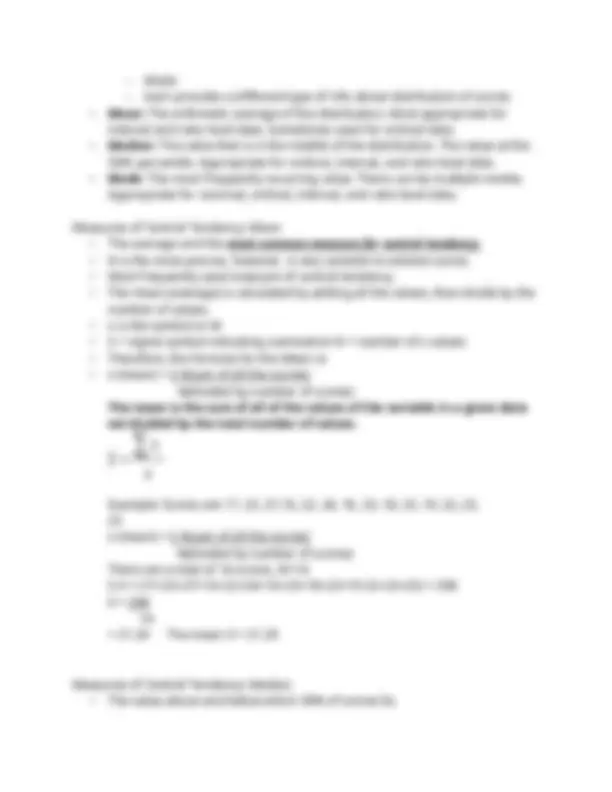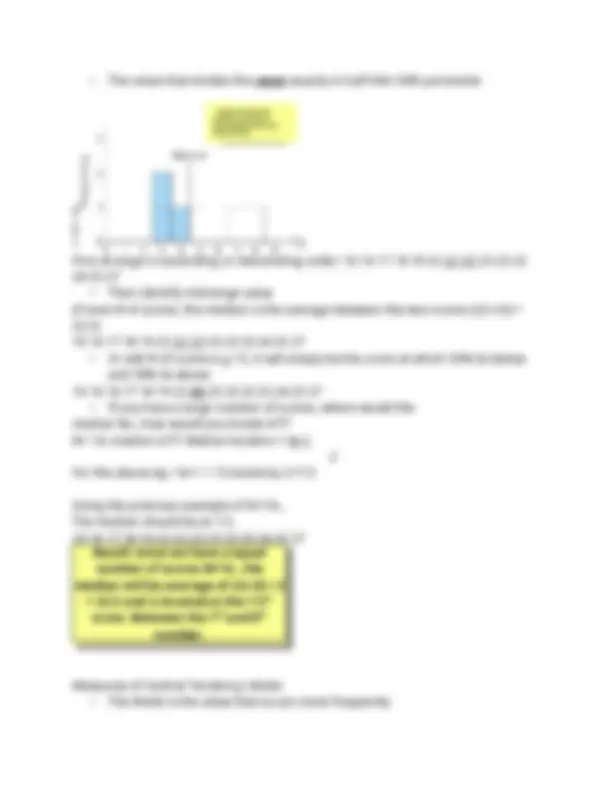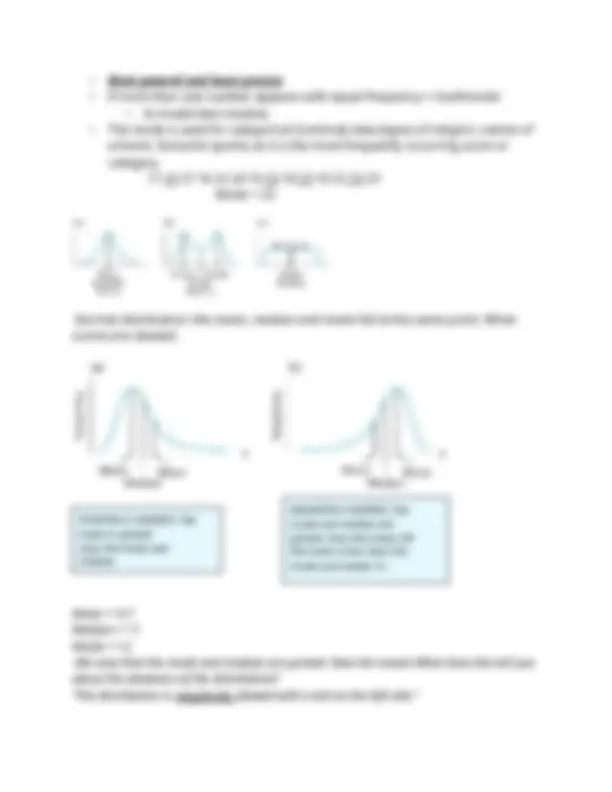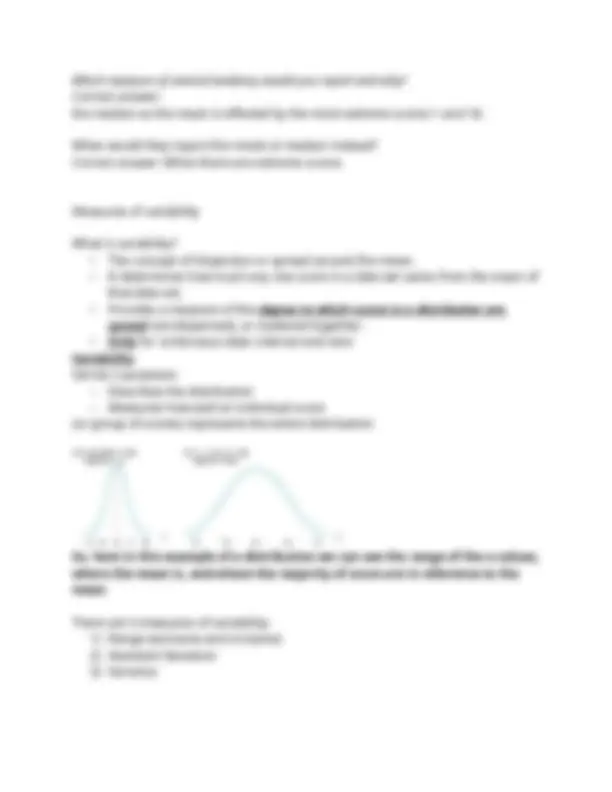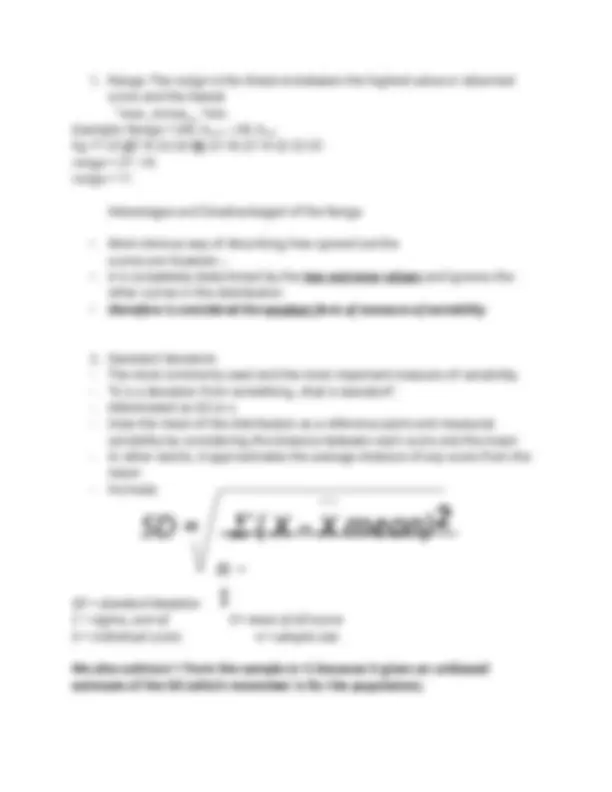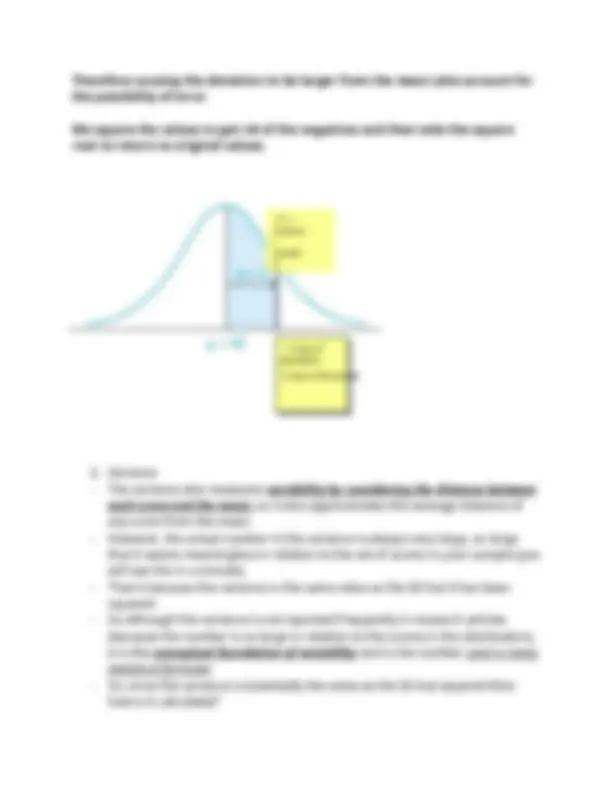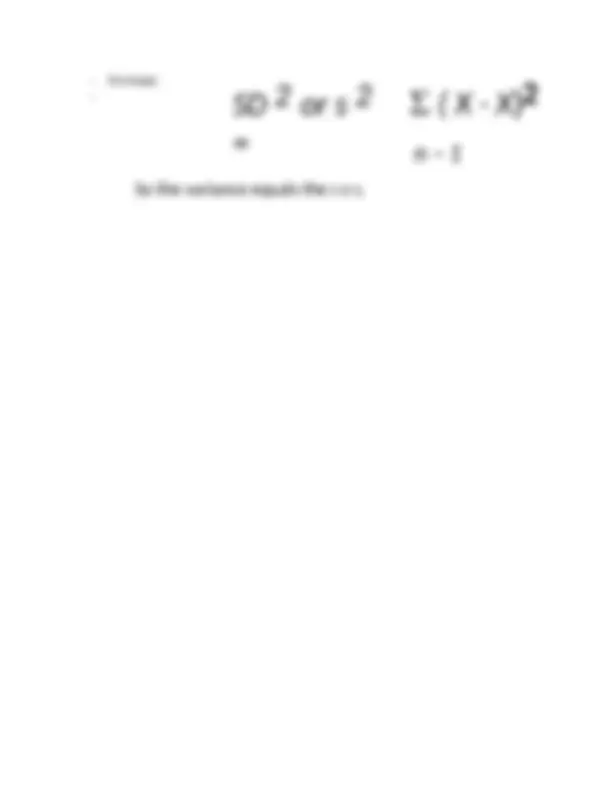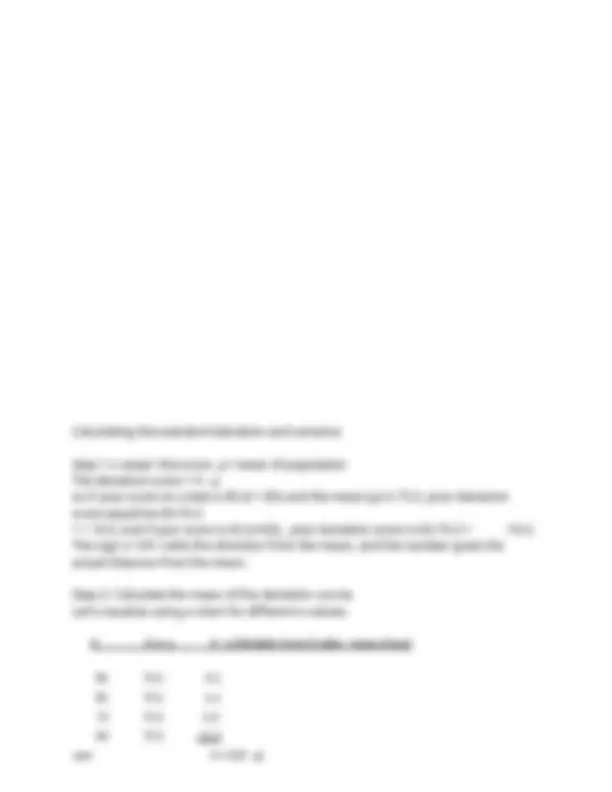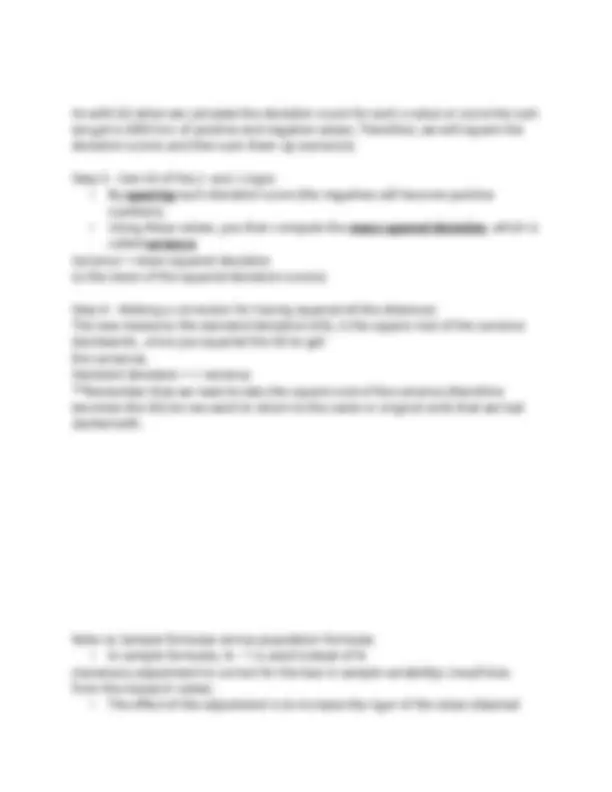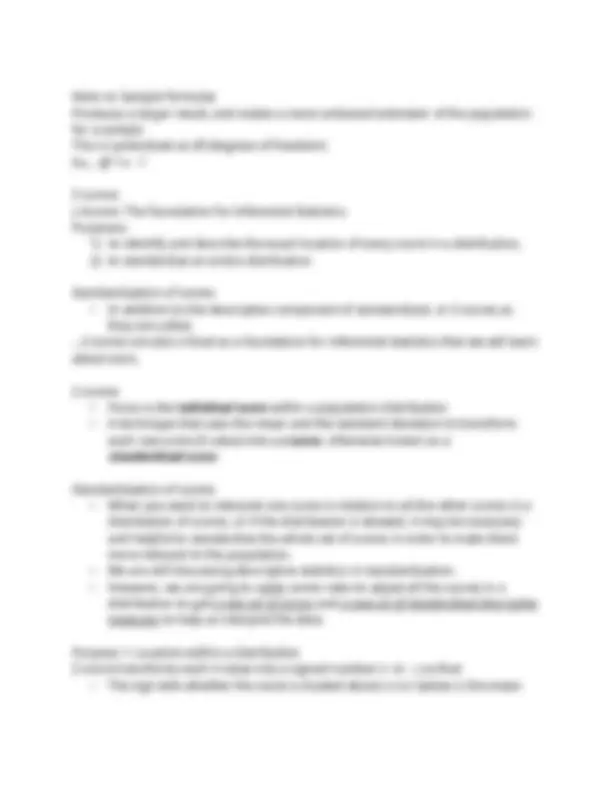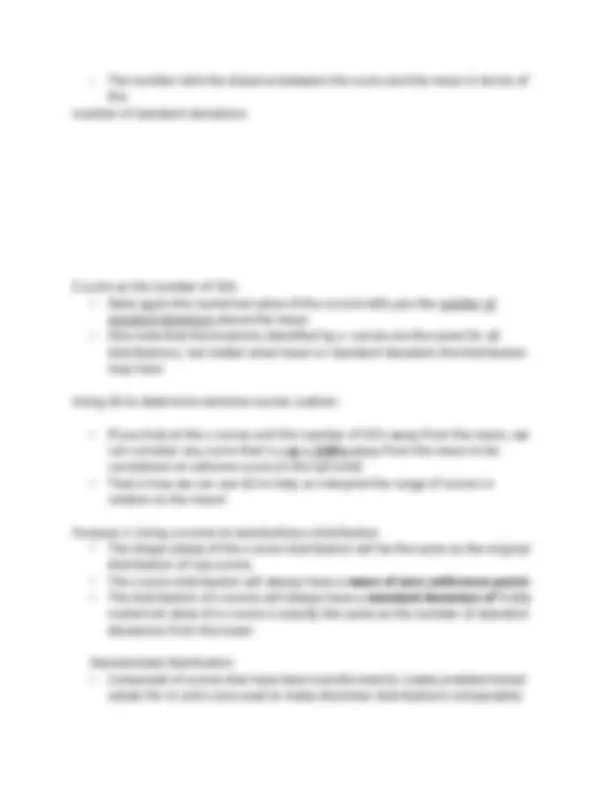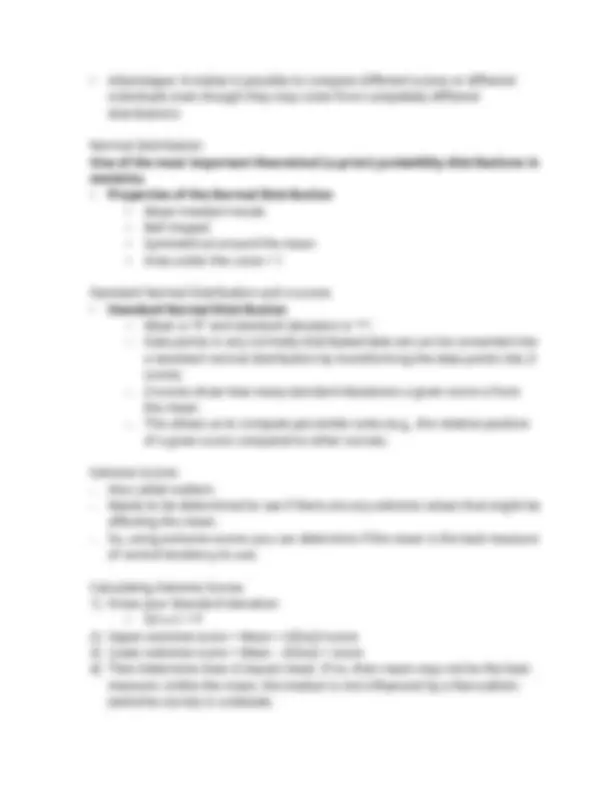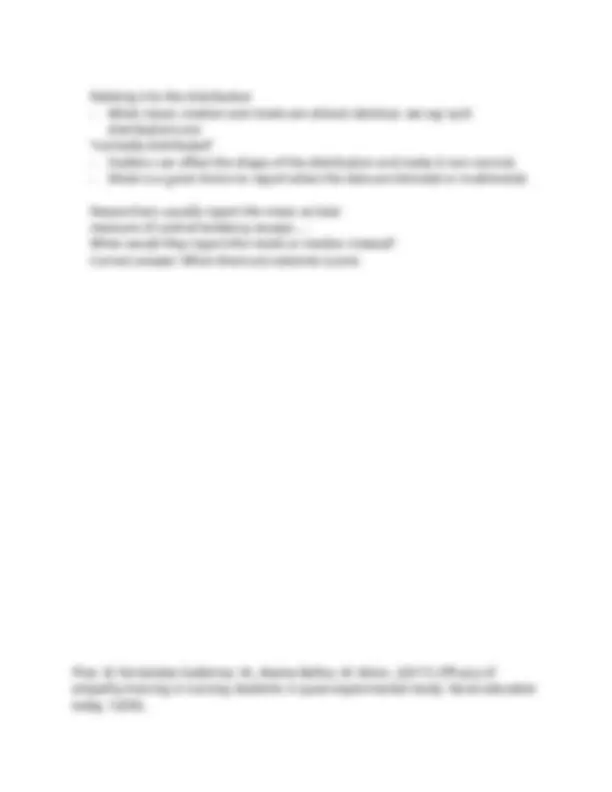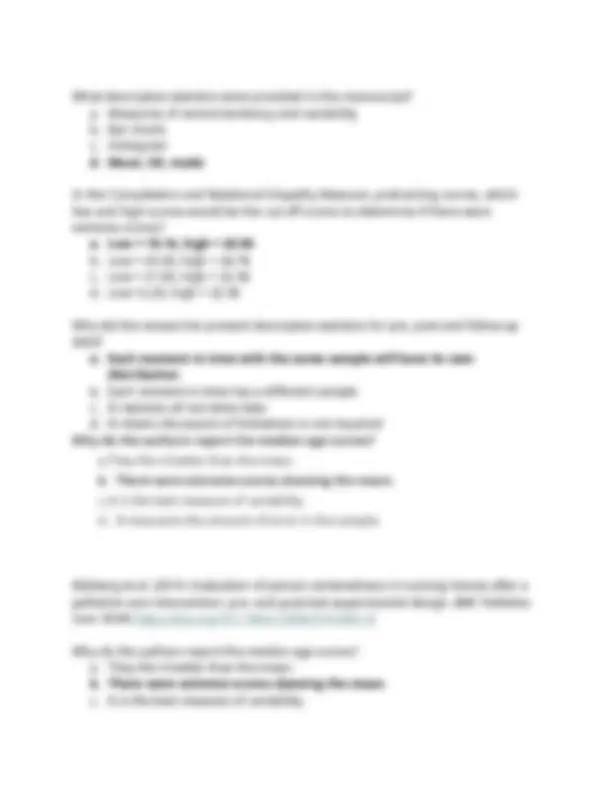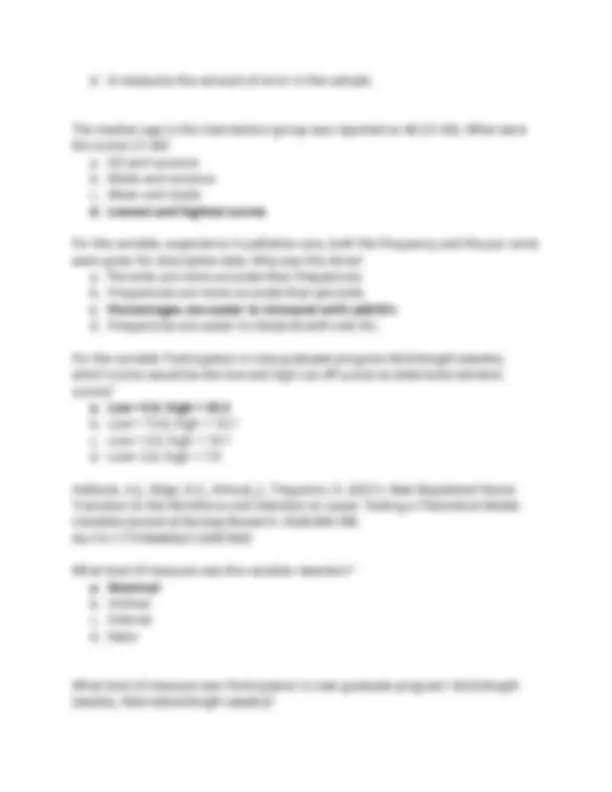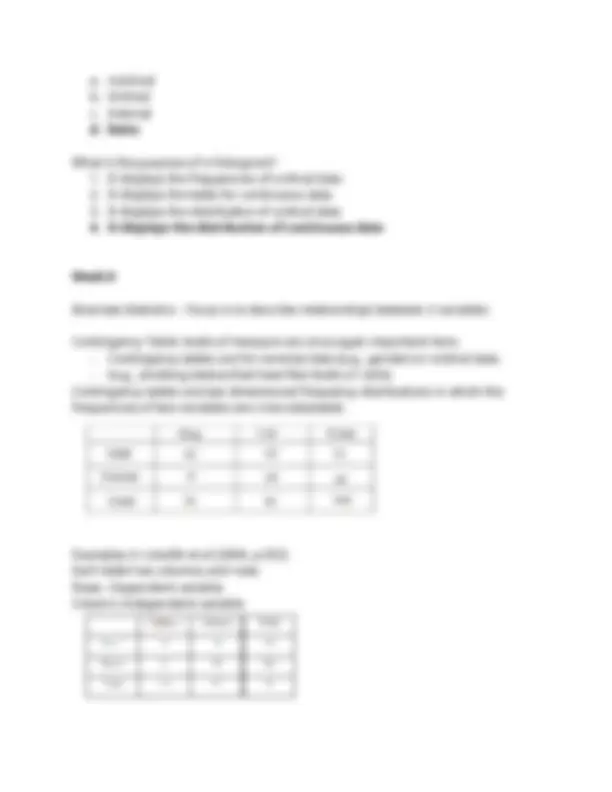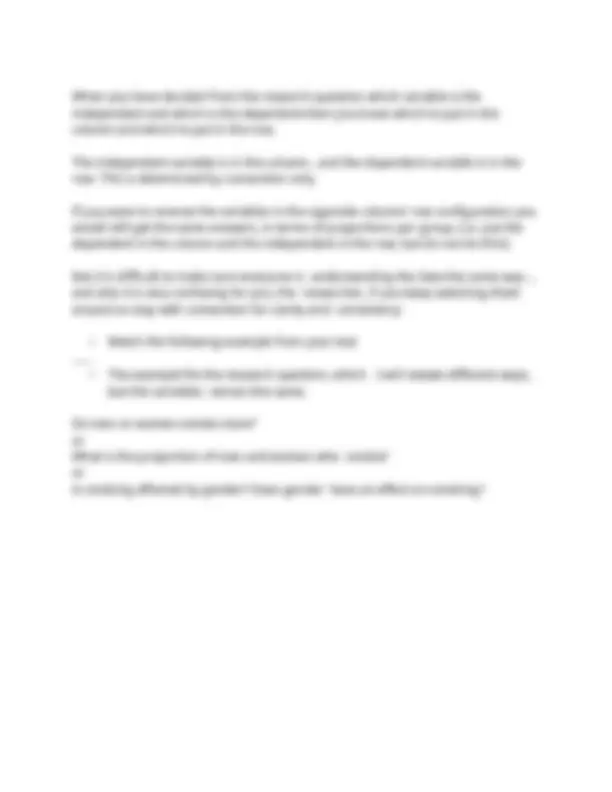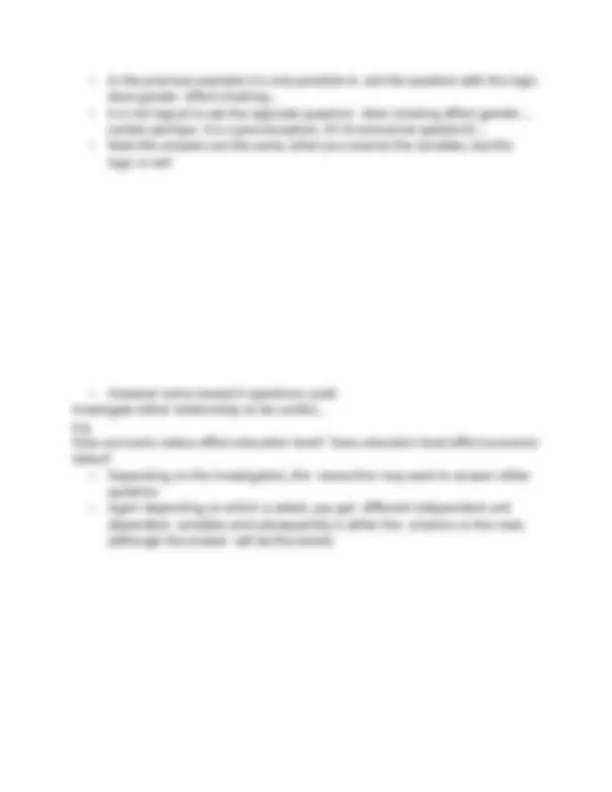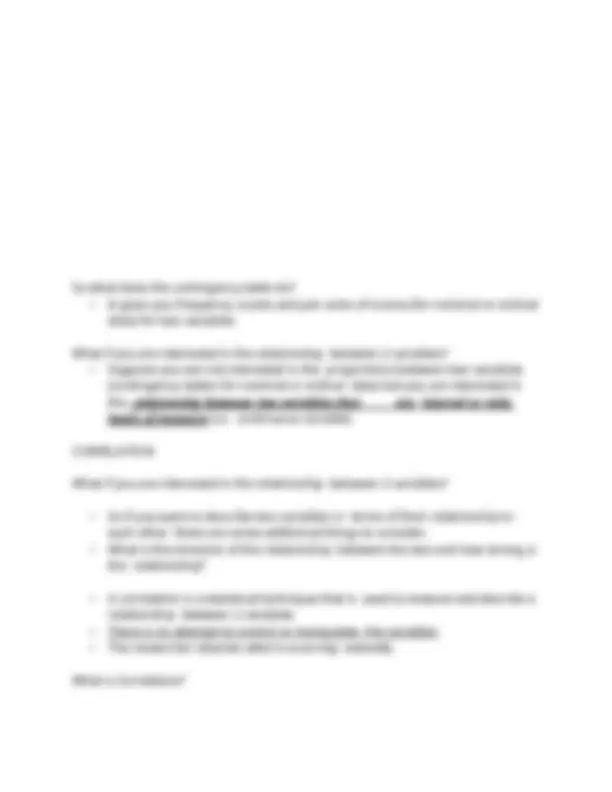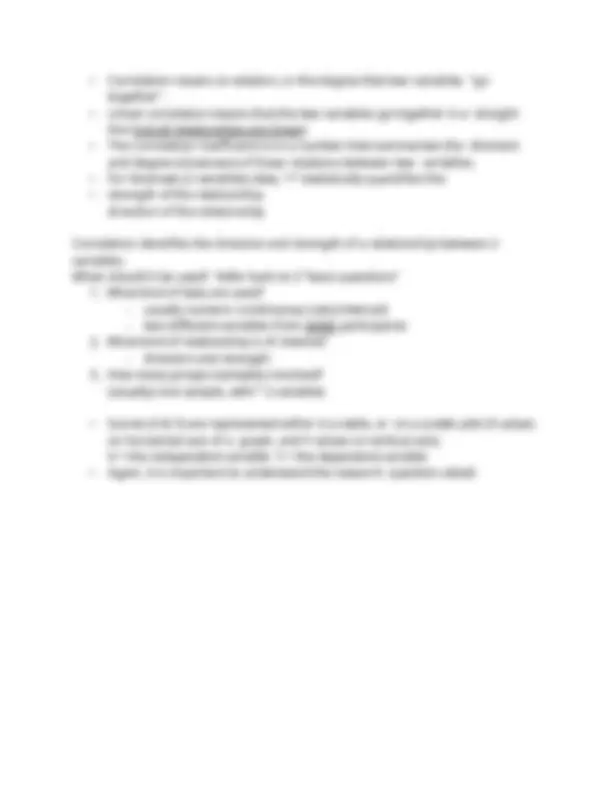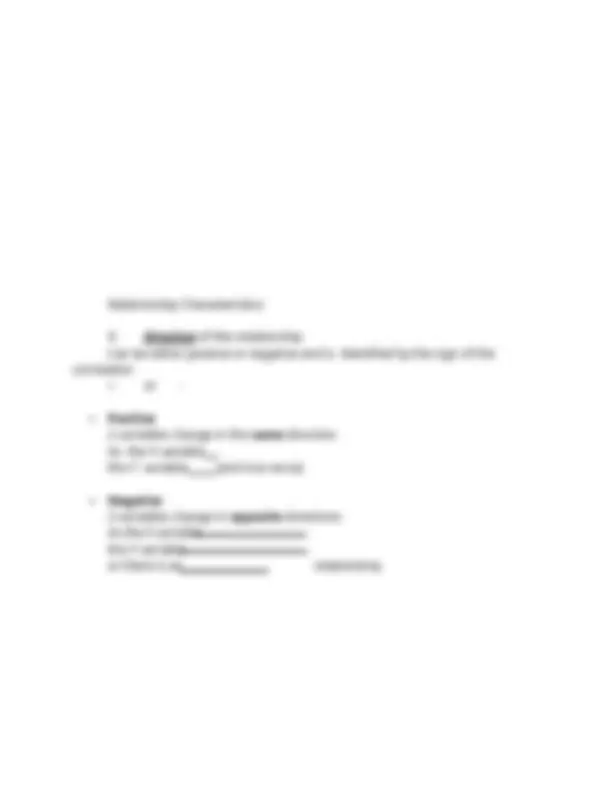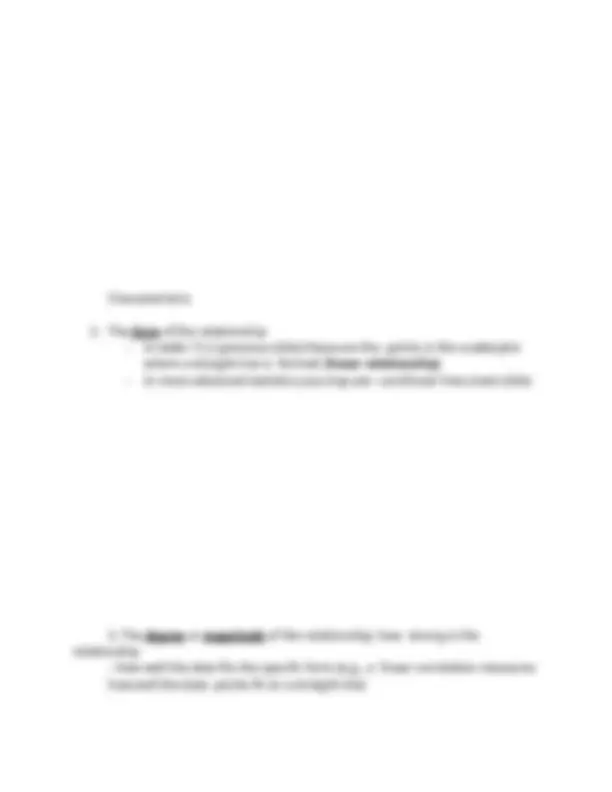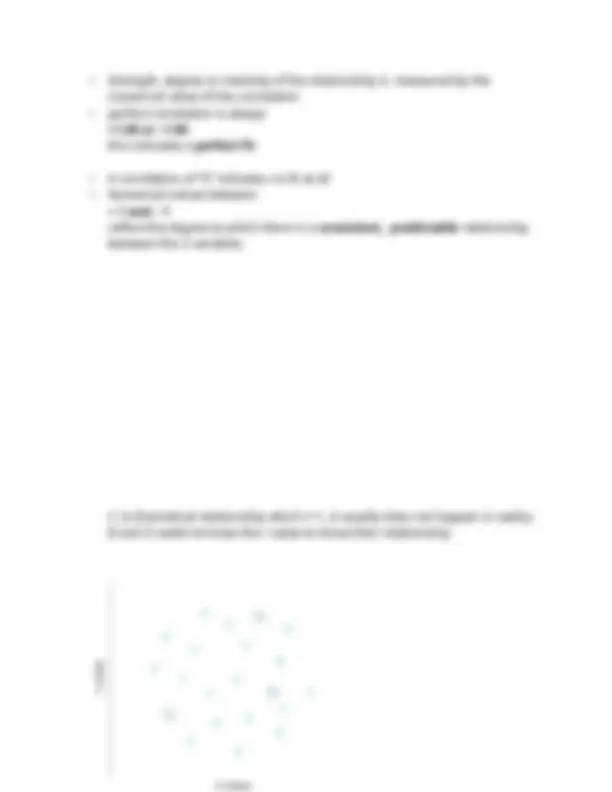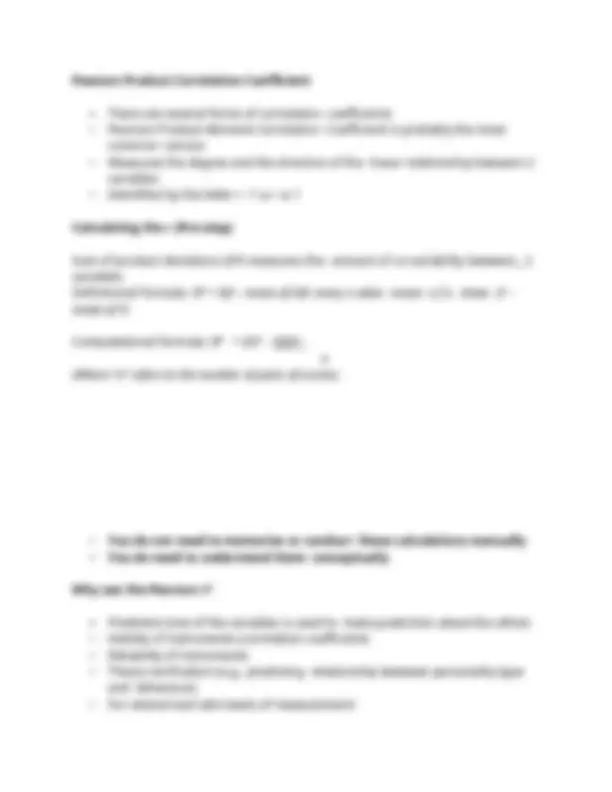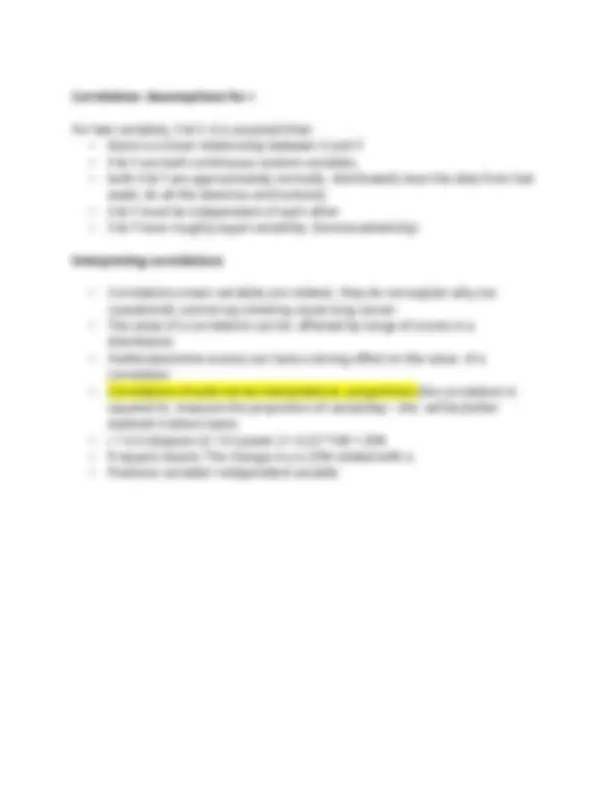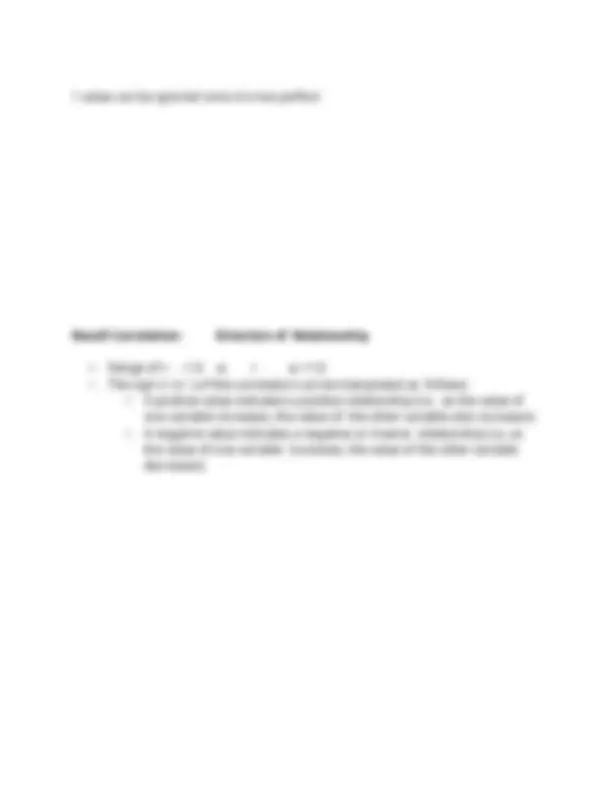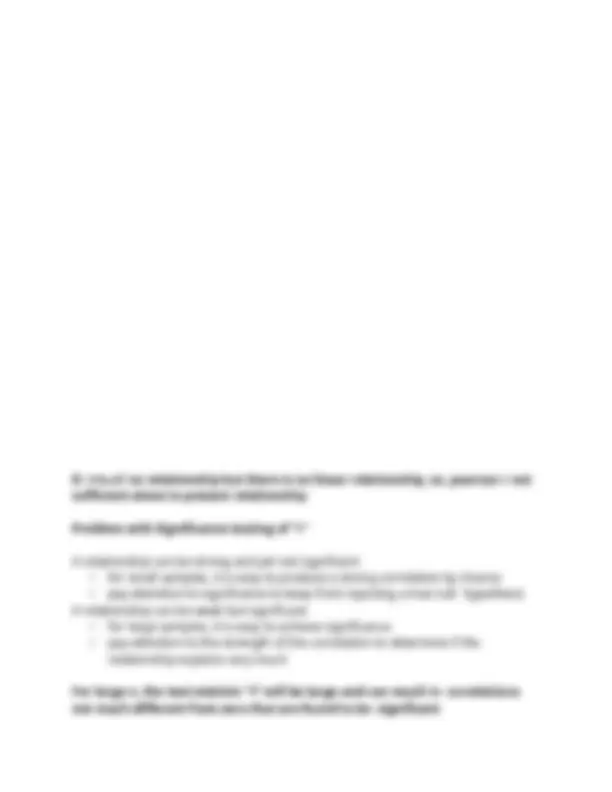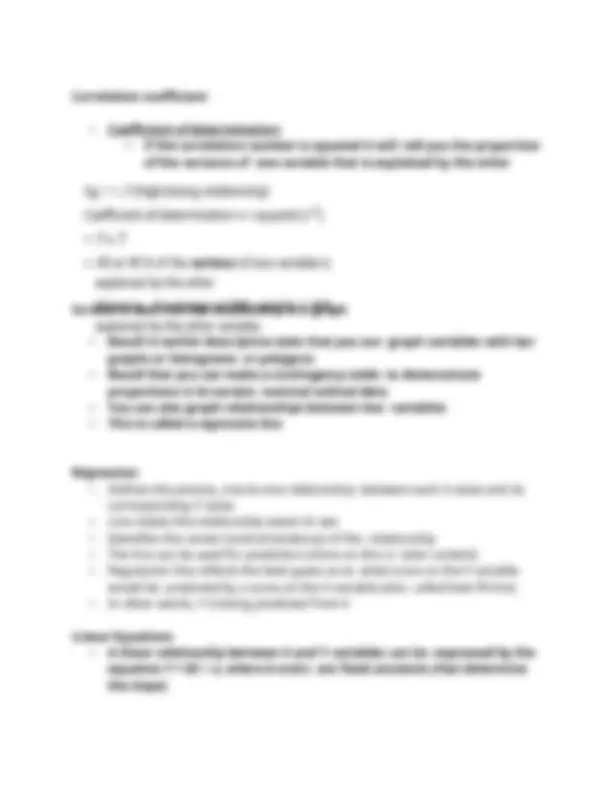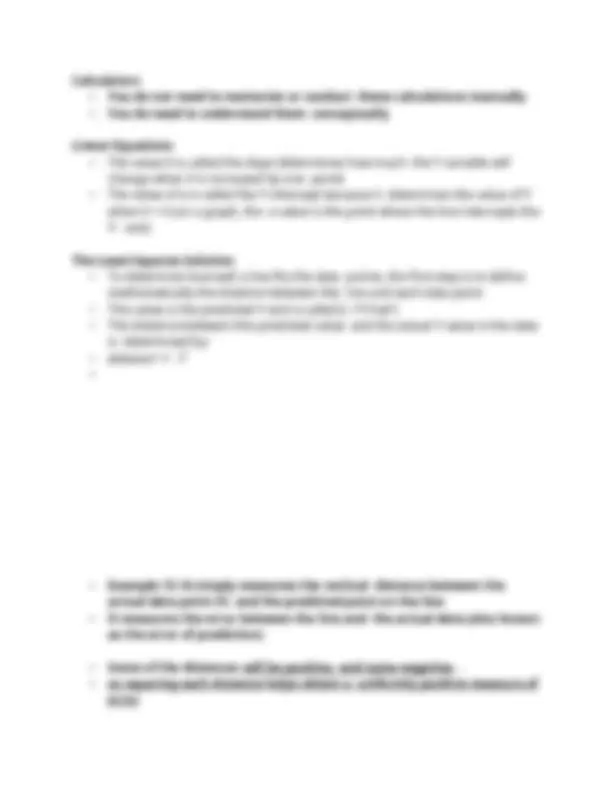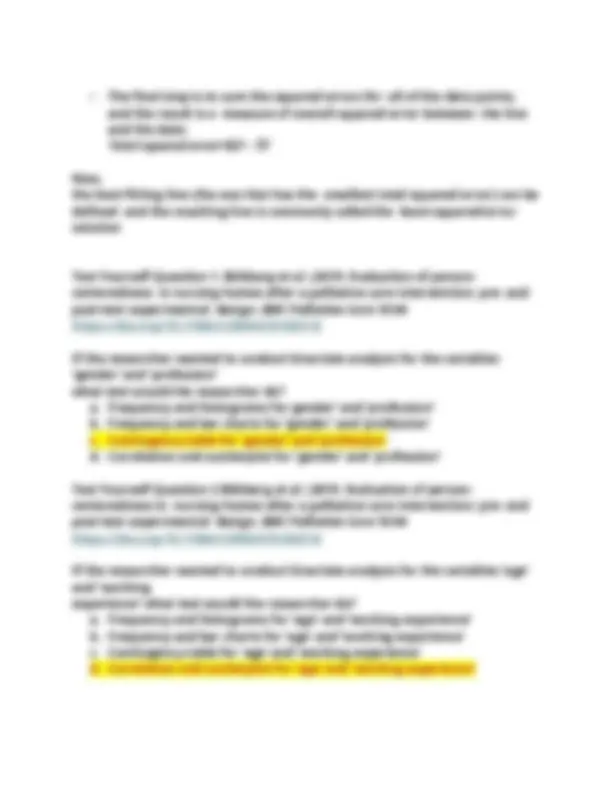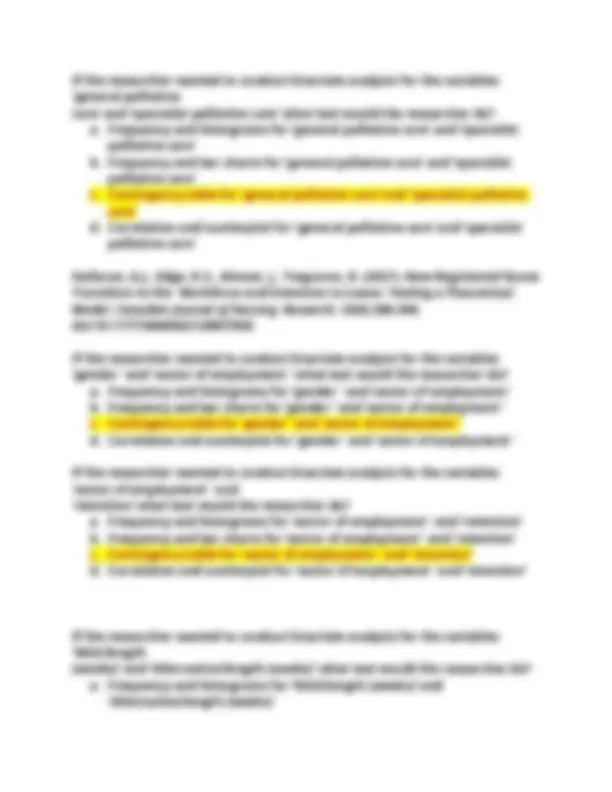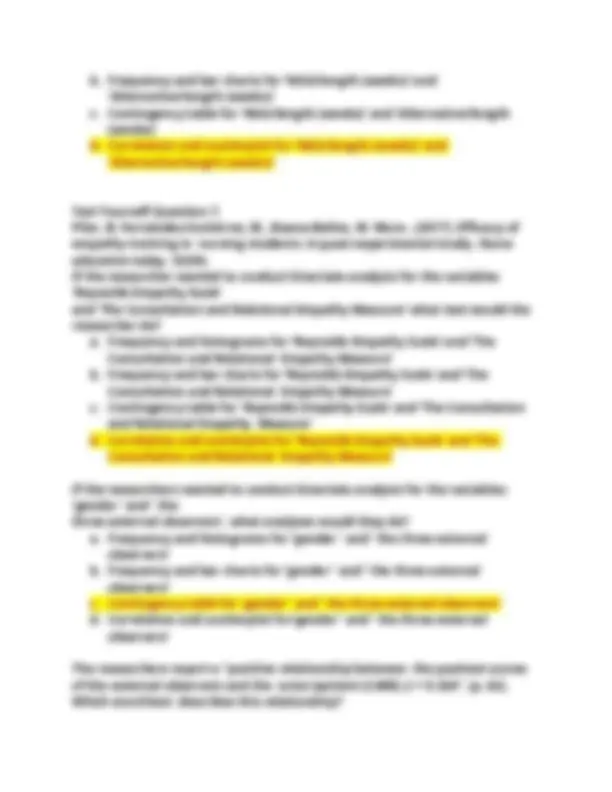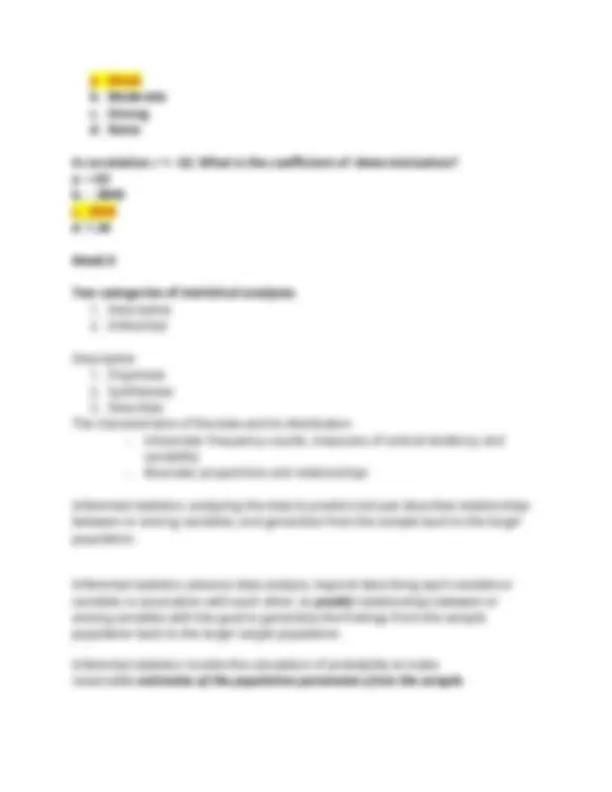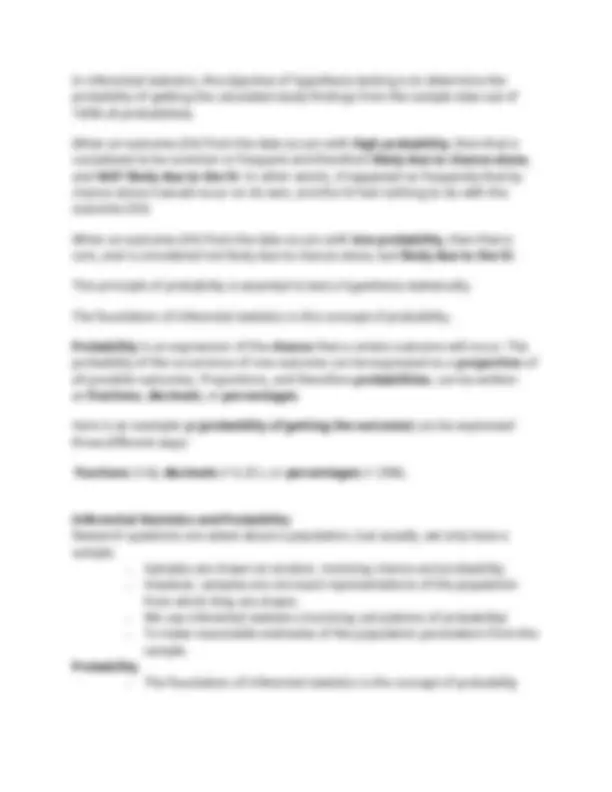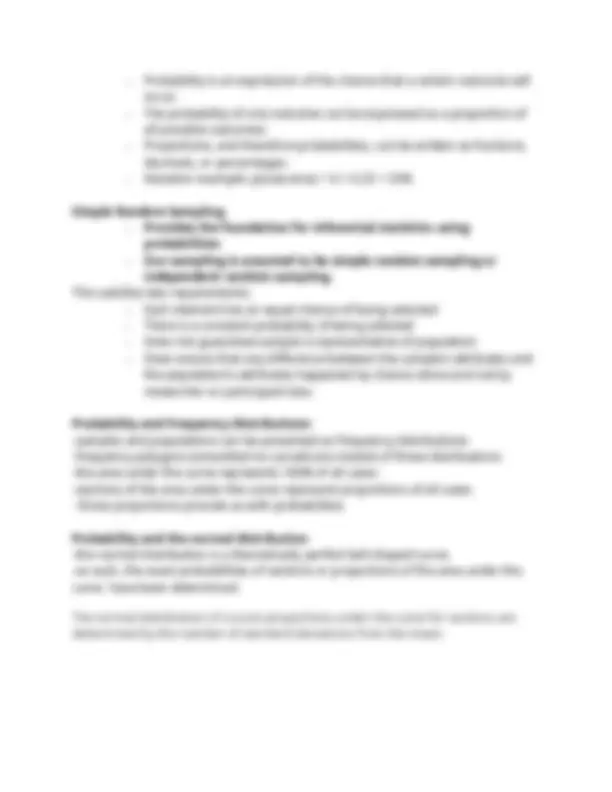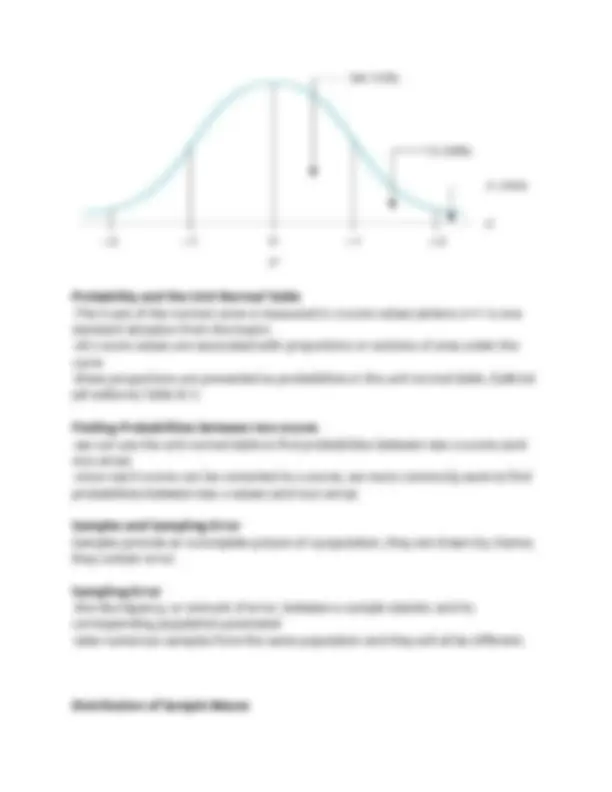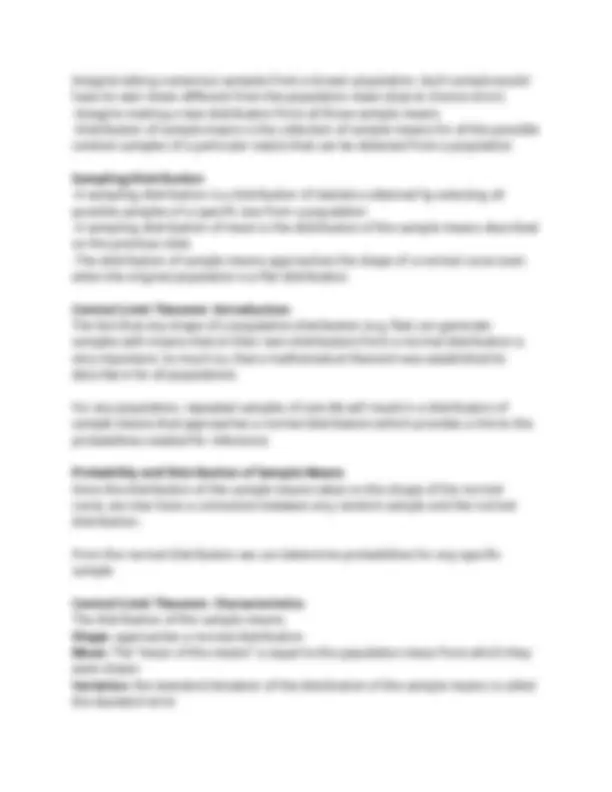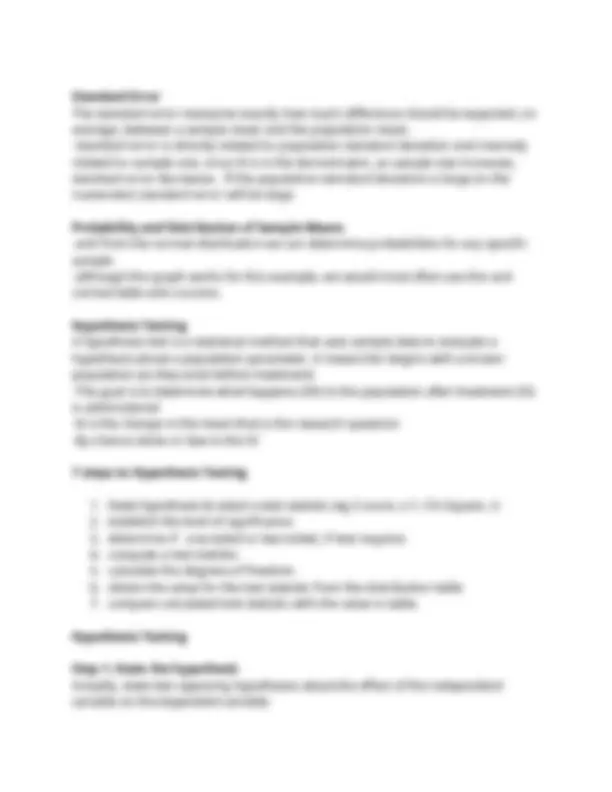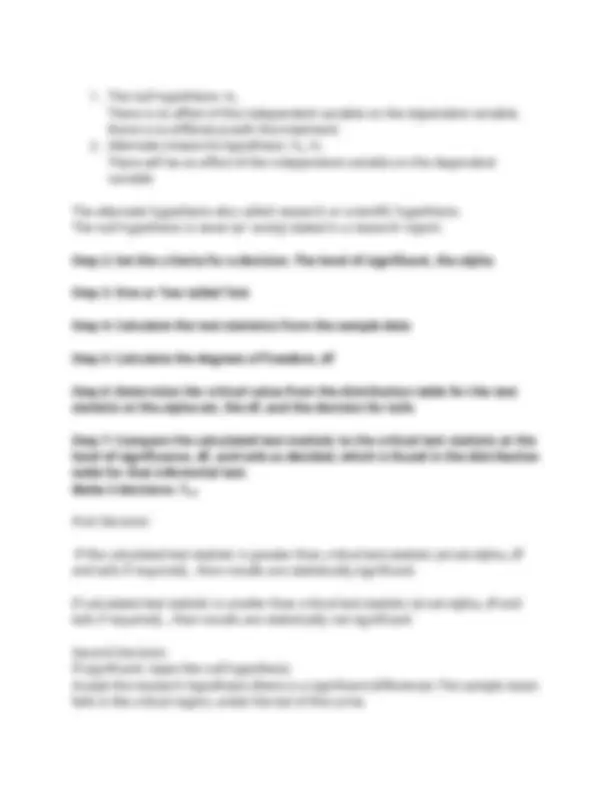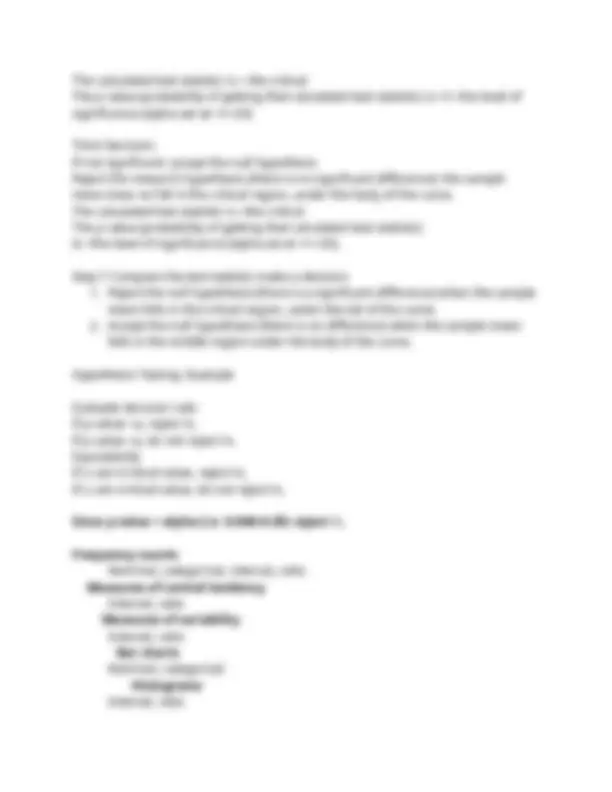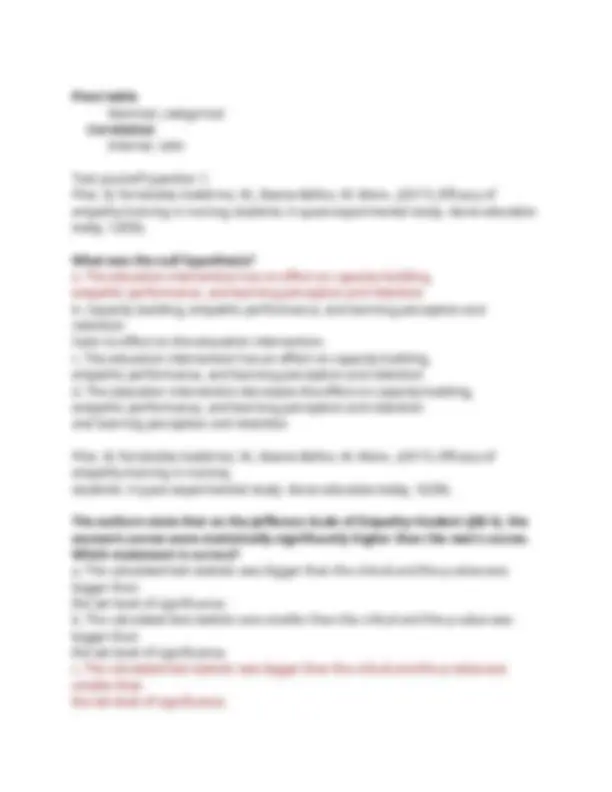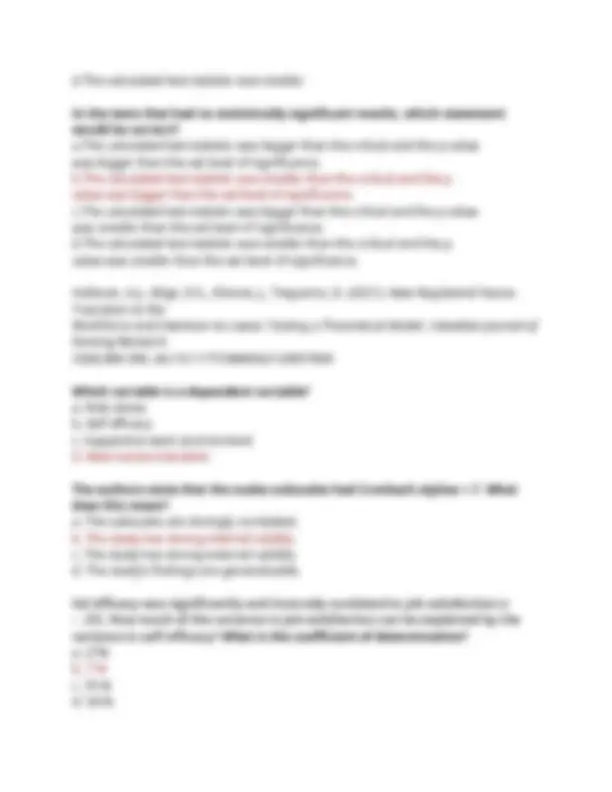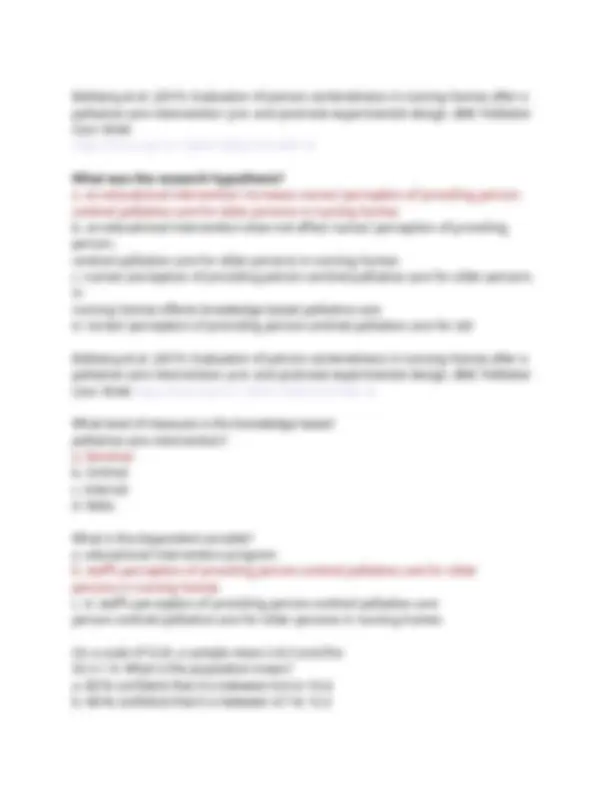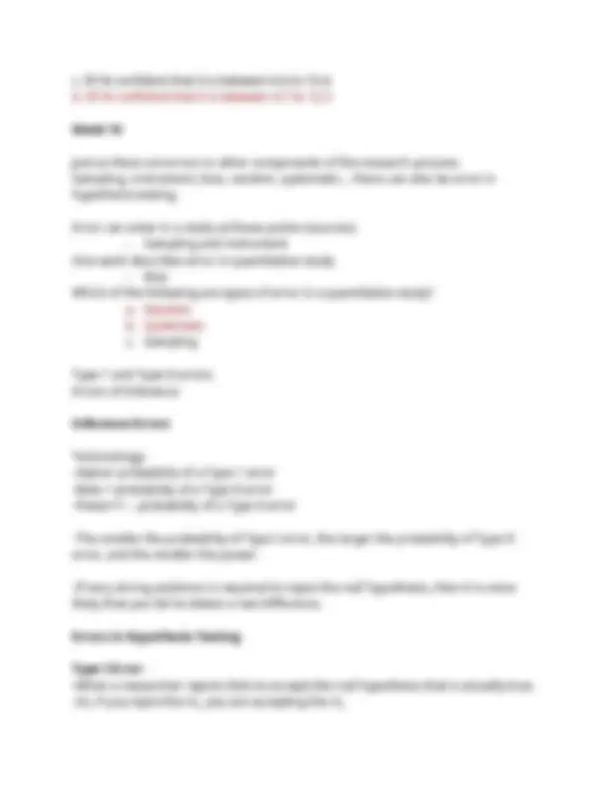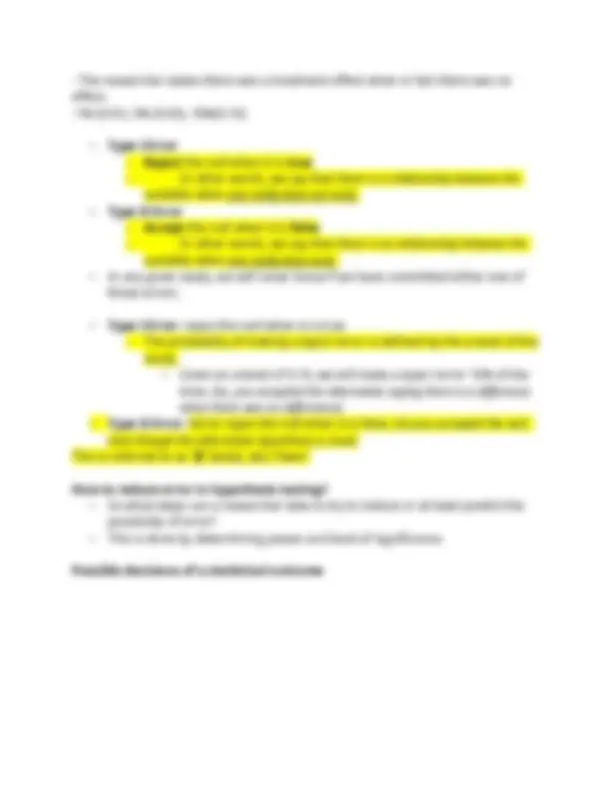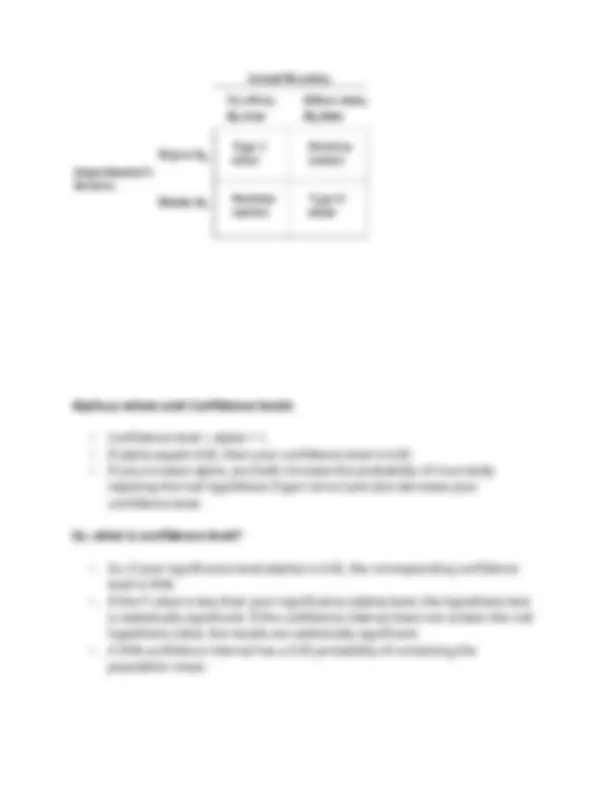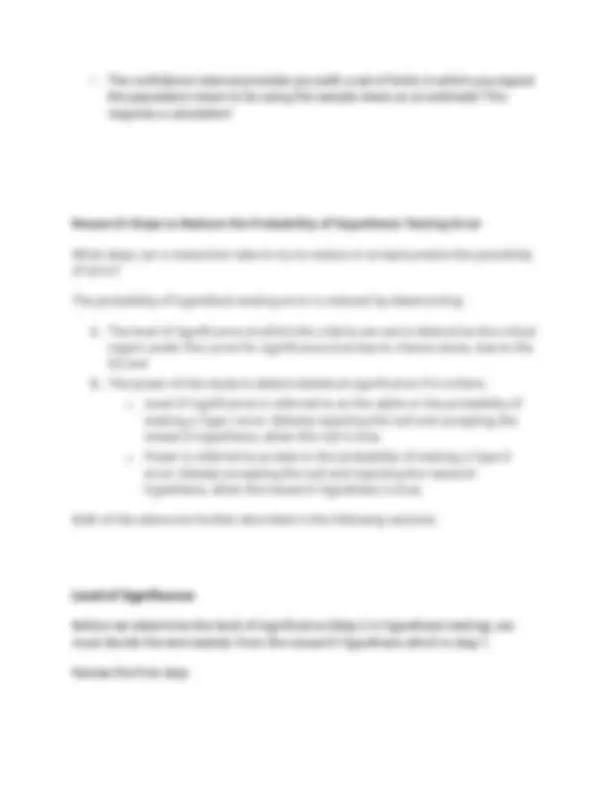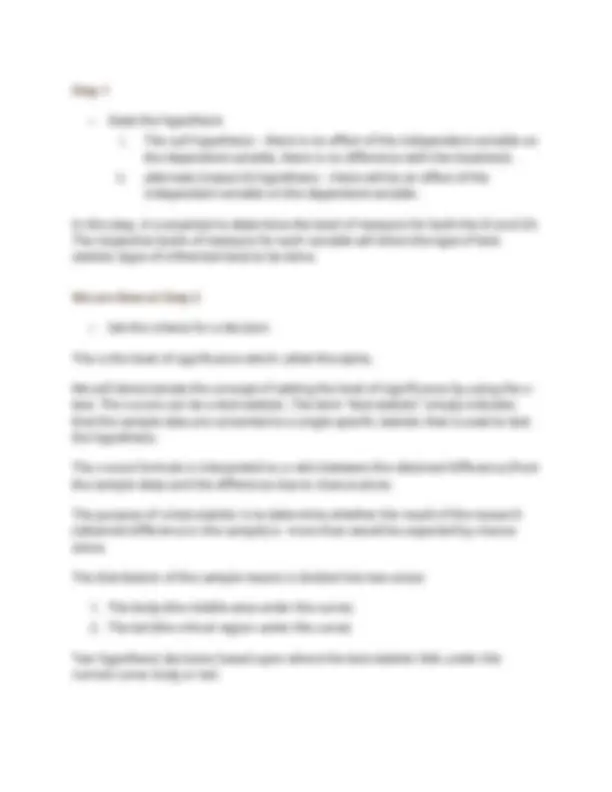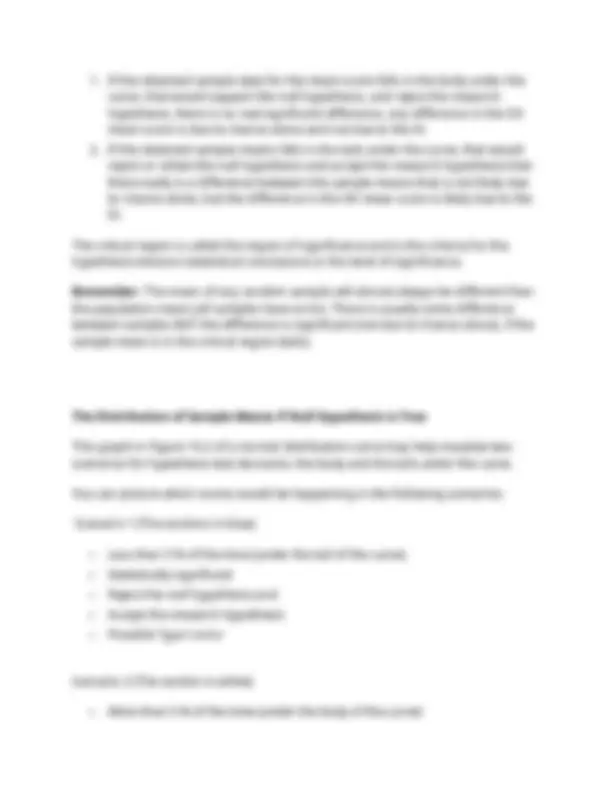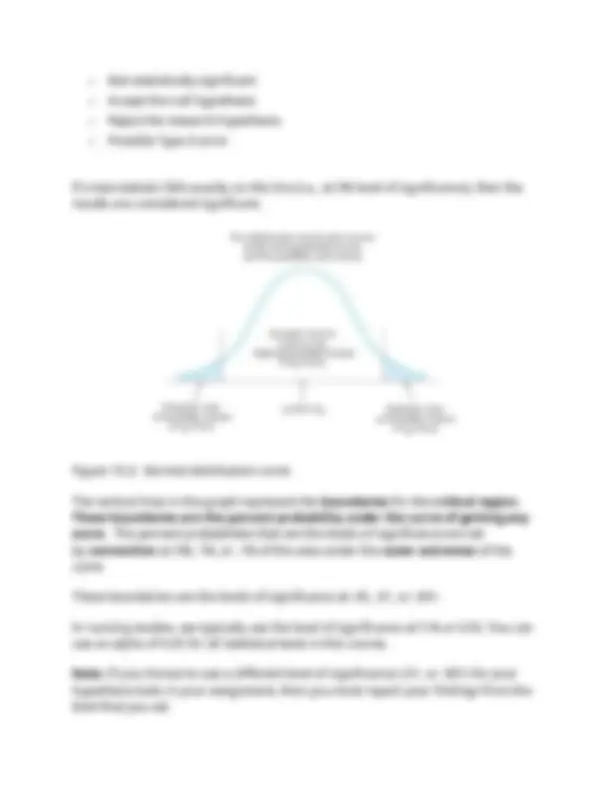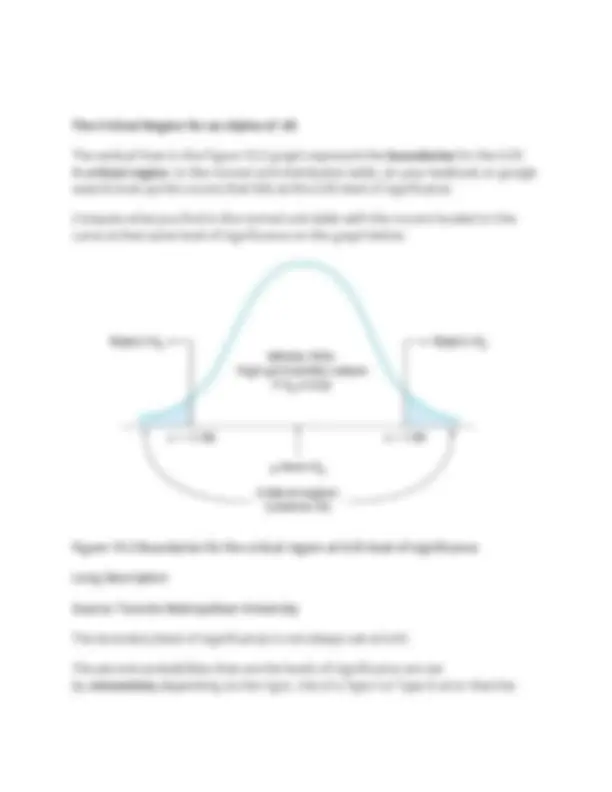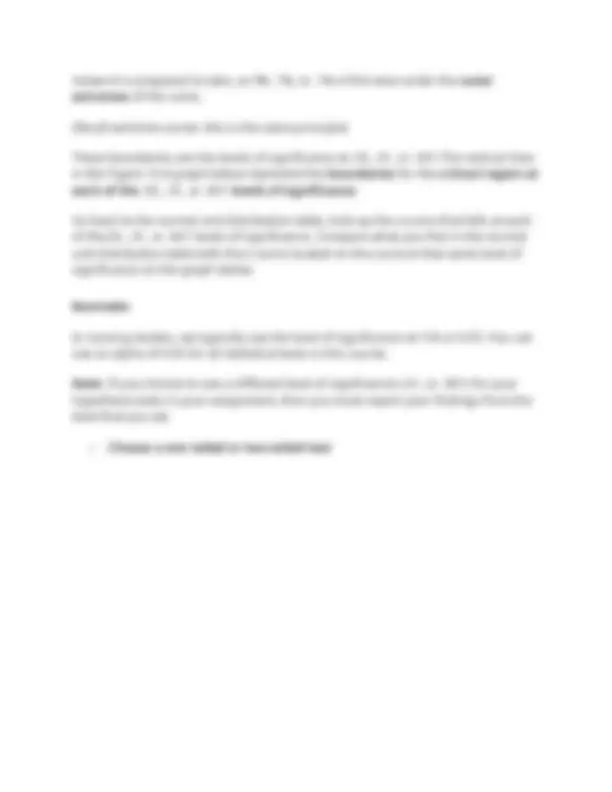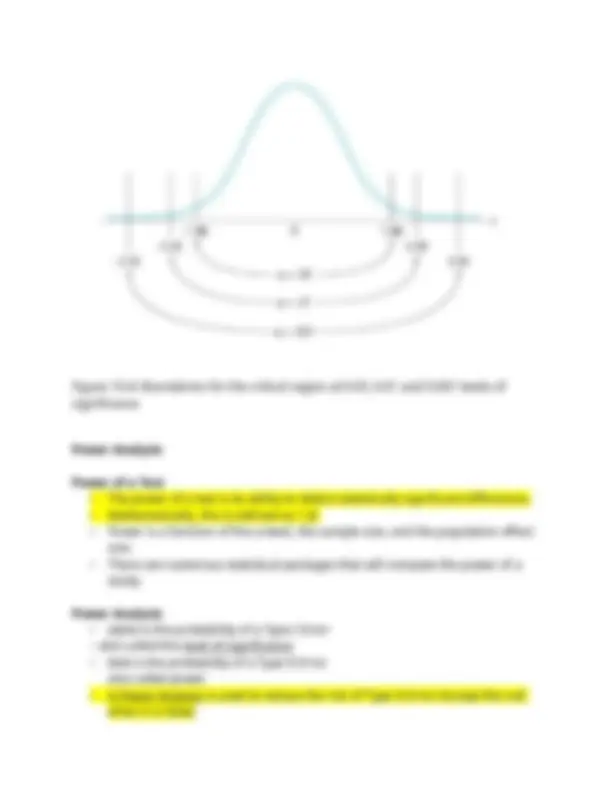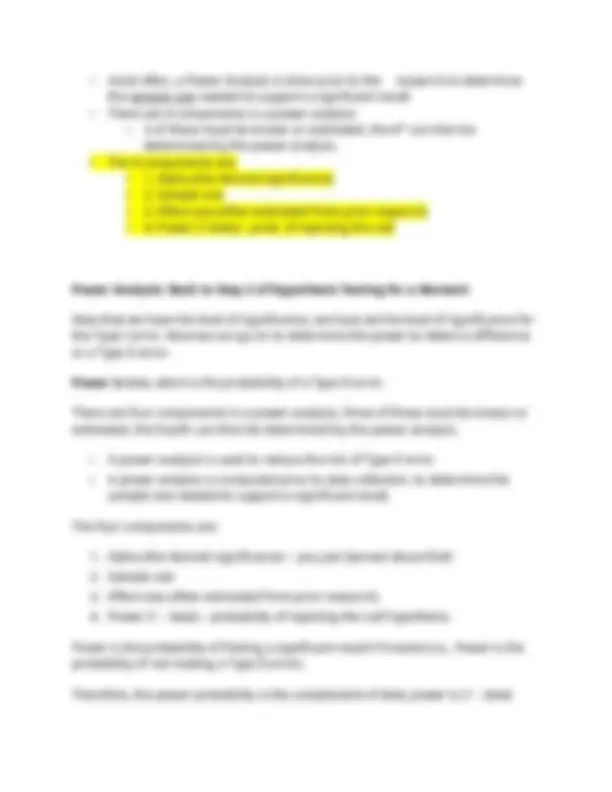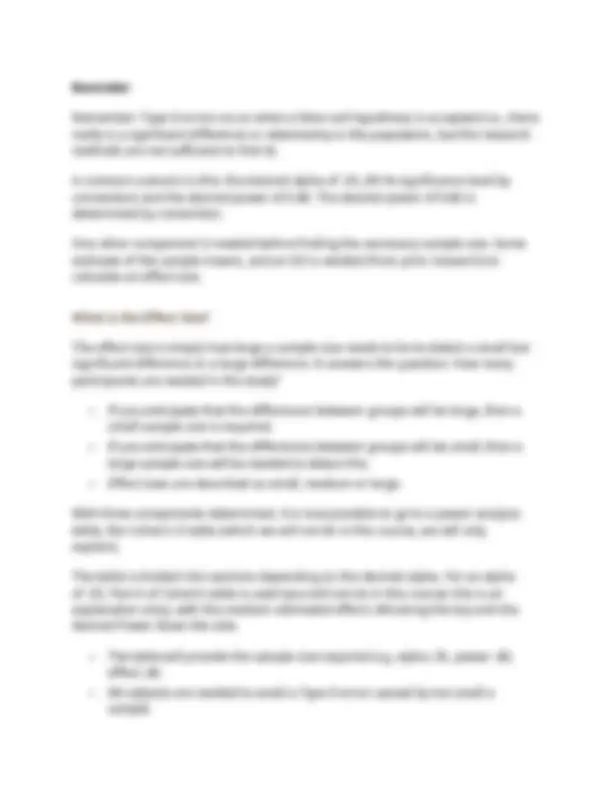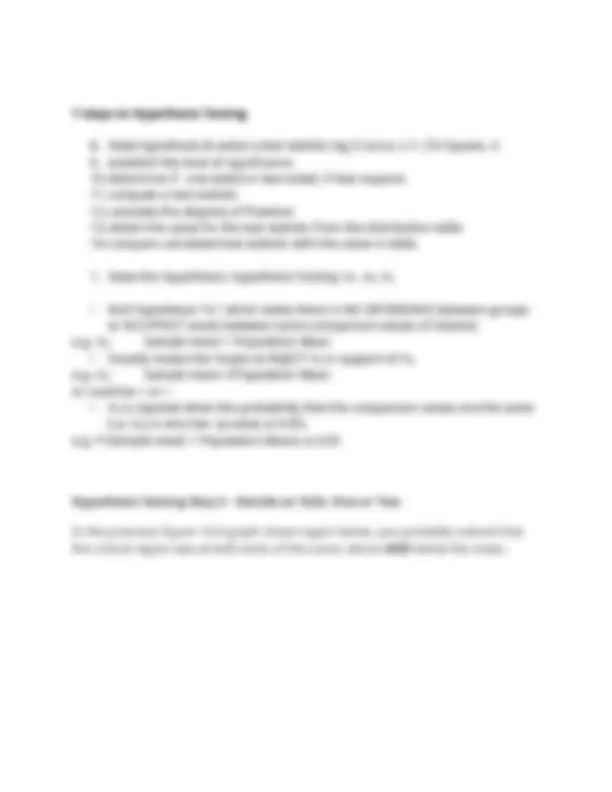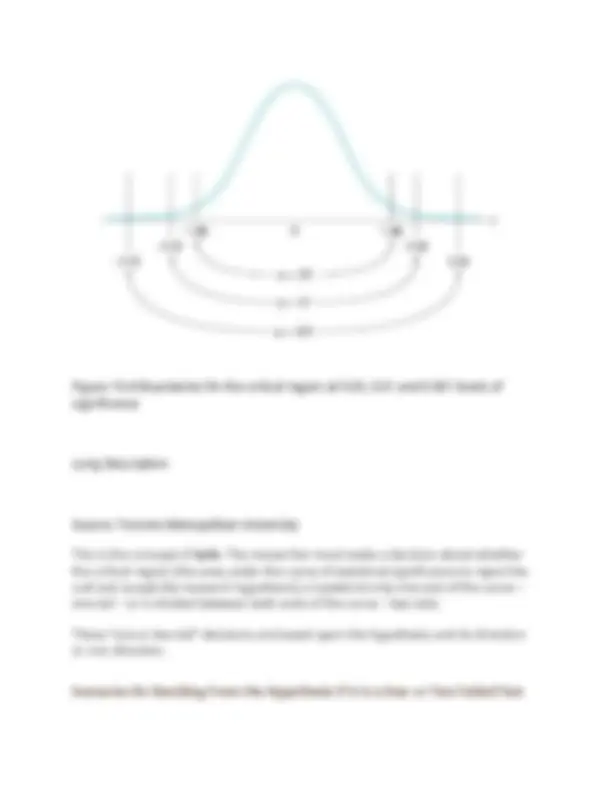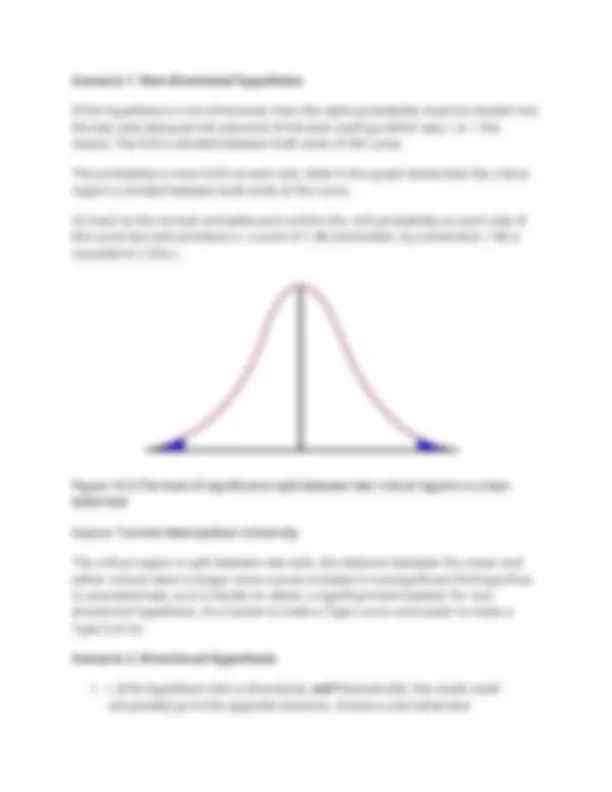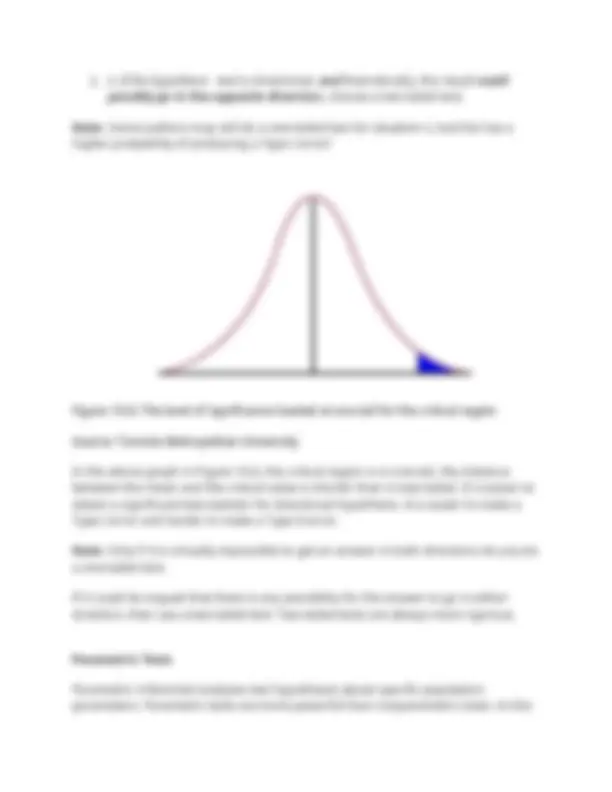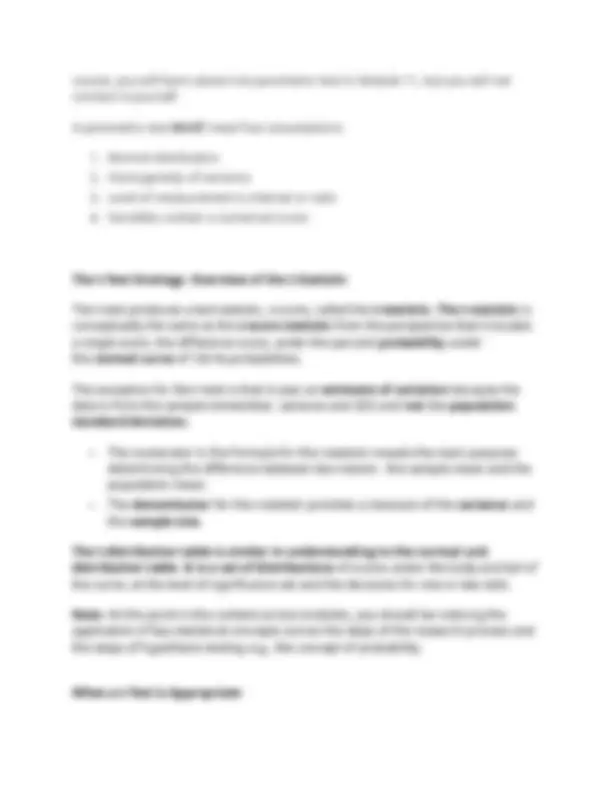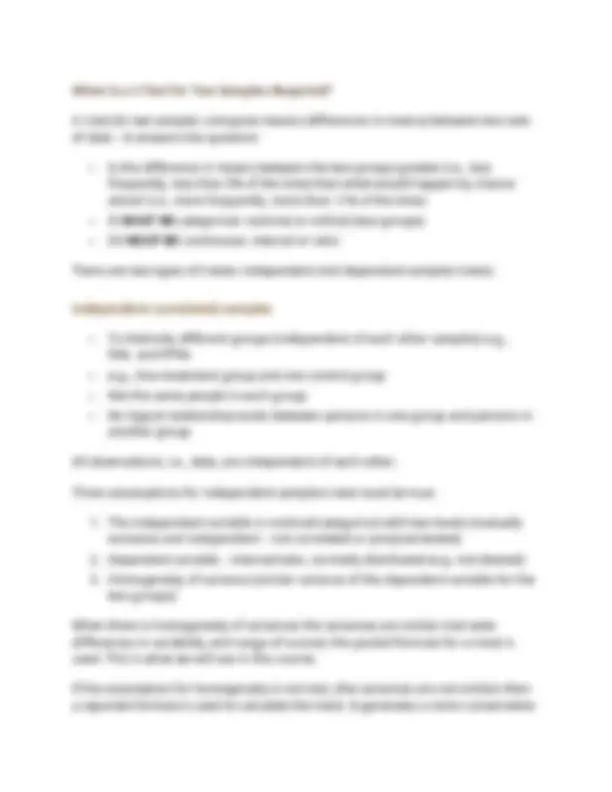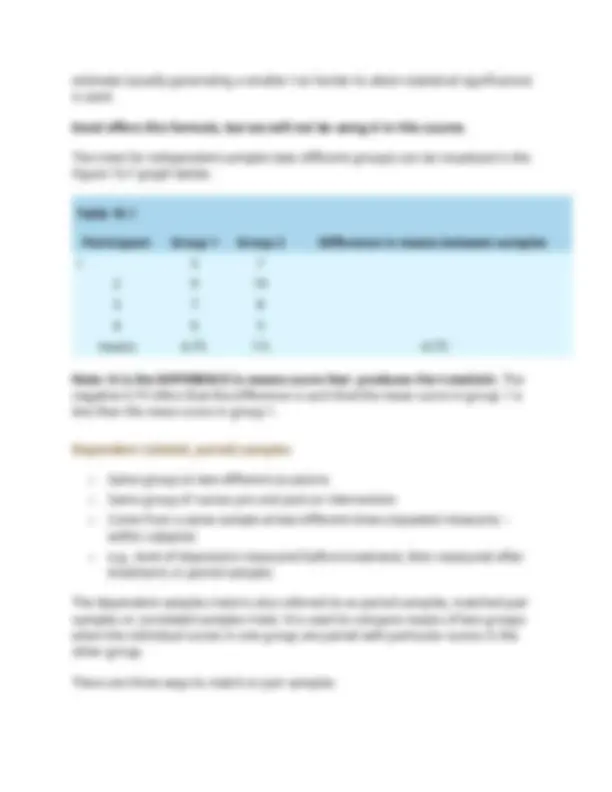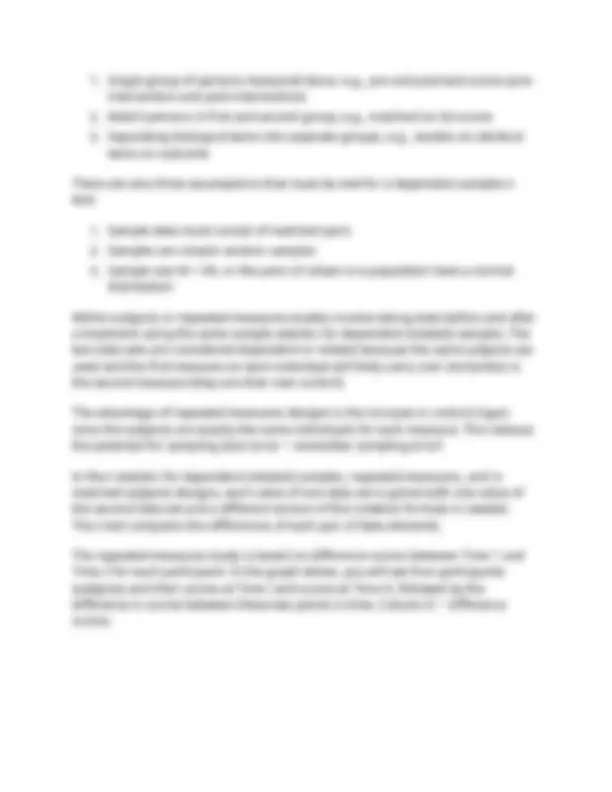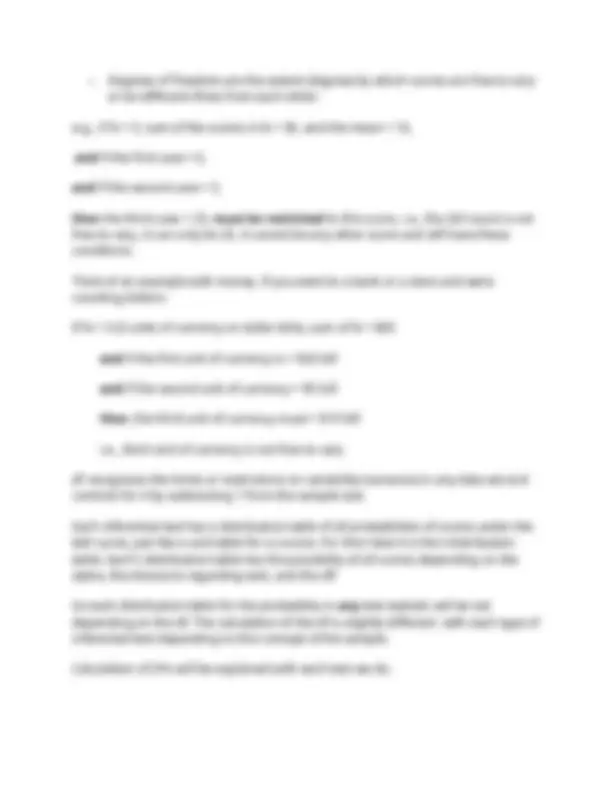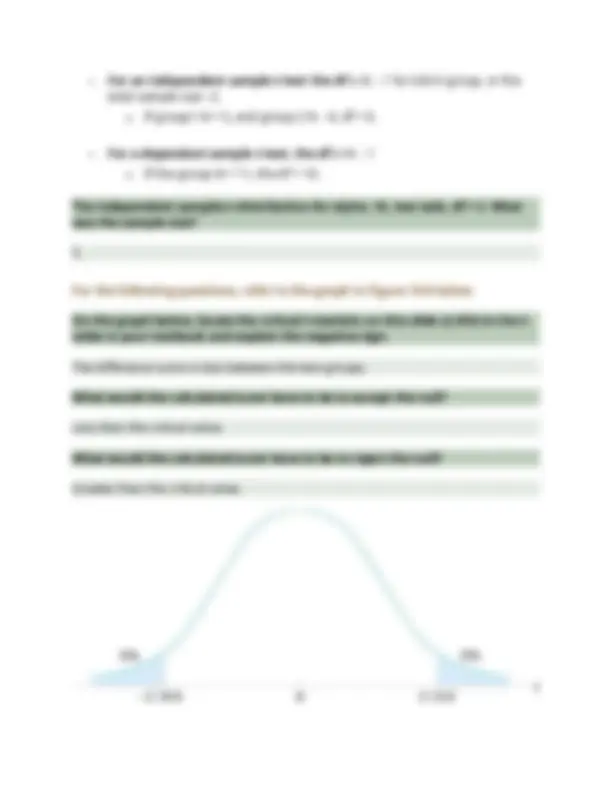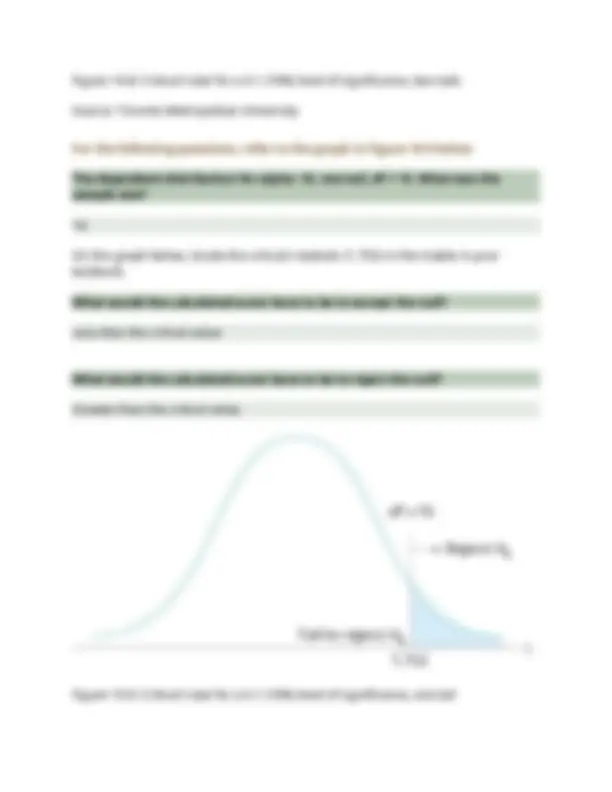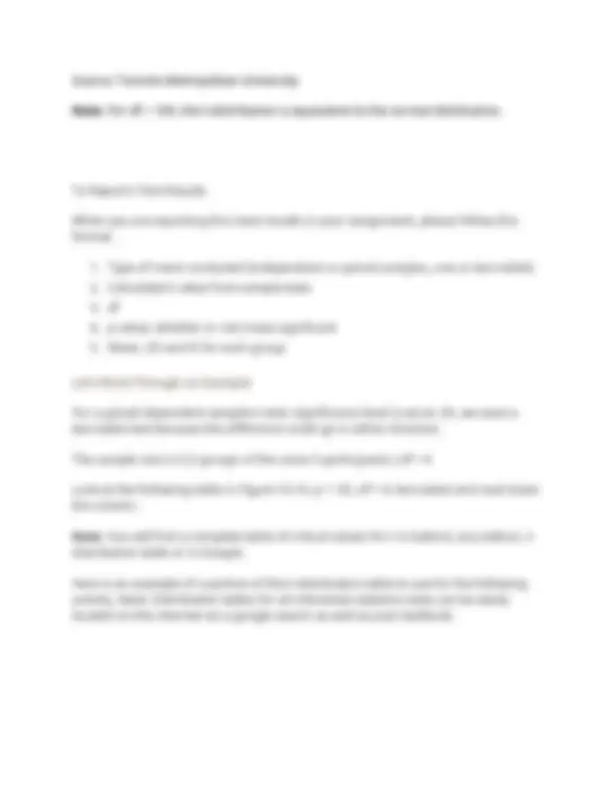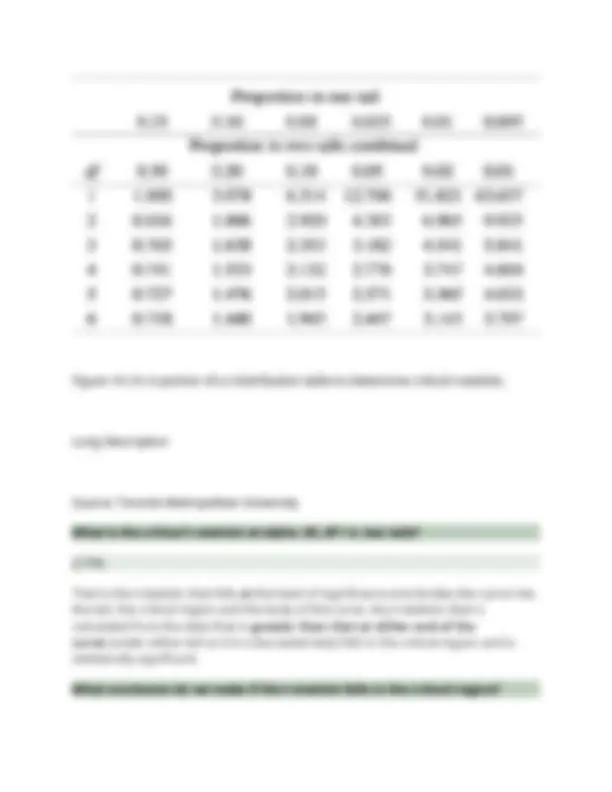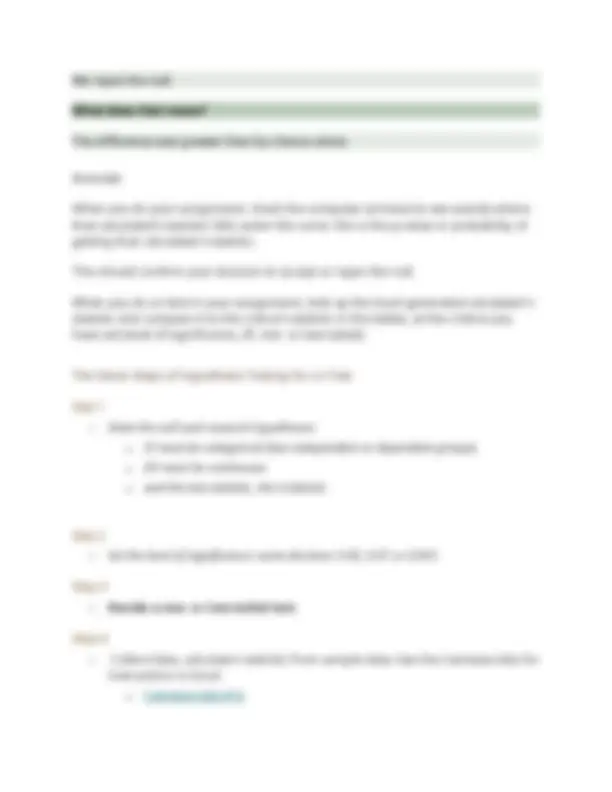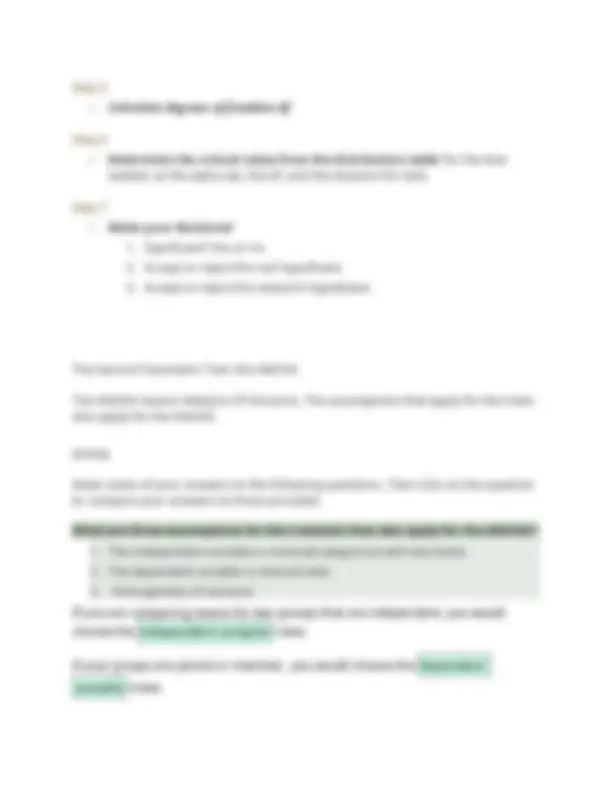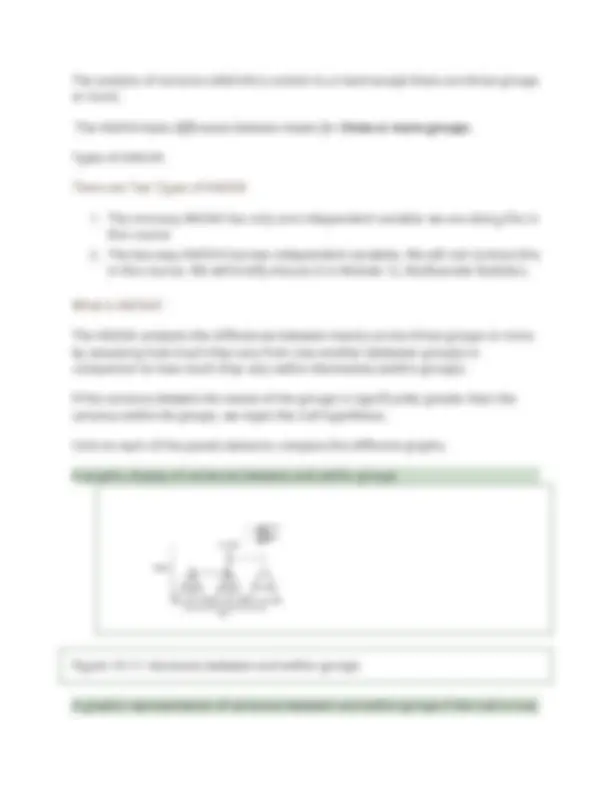Download Descriptive Statistics: Measures of Variability and Correlation and more Summaries Nursing in PDF only on Docsity!
Week 6 Concept to variable to data Recall the research question and hypothesis-> The theory frames the question and hypothesis with concepts that are predicted to have a relationship with each other -> Concepts are abstract ideas that have to be measured by numbers for quantitative research -> Concepts have operational definitions = variable= the parameters of applying numbers to the abstract concept-> The operational definition will guide how data will be collected and what type of numeric data is most appropriate to measure it-> Concept to variable to data to level of measure. For researchers to be sure that they are measuring only the concept, and nothing else but that concept, the definition of the concept’s meaning must be redefined with parameters for its measurement. This is called the operational definition. It is the operational definition that creates the variable (independent or dependent). The operational definition consists of the parameters to apply numbers to the abstract concept. The operational definition guides what type of numeric data is most appropriate to measure the concept and how that numeric data needs to be collected. This produces quantitative data. How Quantitative Data can be collected: Data Collection Methods Quantitative data can be collected from either
- Existing data
- New data Existing Quantitative Data Existing data is information that is already present in documents. In some situations, the information is already in numeric form; in other situations, the data is narrative, and numbers are calculated by counting how often the narrative
occurs. The following are examples of data that exists already that may be used by researchers to answer a research question. i. Results from previous studies: Large amounts of data from across numerous studies can be collapsed to create one large data set. Then the entire data set from many studies can be analyzed together. This is called a meta-analysis. ii. Historical research, diaries, letters, newspaper reports: These are often examples of existing narrative data that is counted for how often certain words, ideas, events, or themes occur in the narratives. iii. Data from previous studies: These may be analyzed a second time to answer a new and different research question to test new hypothesis. This is called a secondary analysis. iv. Records such as health records: You are likely very familiar with this scenario. Client records hold vast amounts of quantitative data, which can be used to answer specific research questions. New Data Sources for Quantitative Measures Many research questions require new sources of quantitative, numeric data. There are two main types of new data: structured self-report methods, and biological and physiological measures.
- In a structured self-report measure, the questions are prepared, as well as all possible answers. The questions and answers are guided by the operational definition of the variable. The participant answers, or reports on, the questions. Examples of self-report measures are surveys, questionnaires, and score cards.
- Biological and physiological measure methods measure the observed value for a bio-physiological attribute such as blood pressure, pulse, and urine output. Existing Quantitative Data Information from existing data include:
- Results from previous studies: a. Analyze across numerous studies = meta-analysis
- Historical research, diaries, letters, newspaper reports
Levels of Measurement Objective measures are numeric representations of concepts, many of which are abstract (depression) not concrete (height). Each numeric measure will Always have a component of error. Four levels of measure are: From lowest level of mathematical sophistication to highest level of mathematical sophistication: A. Categorical (how many)
- Nominal
- Ordinal B. Continuous (how much)
- Interval
- Ratio Higher levels (continuous) provide more statistical information and greater power, so they are preferred but not always necessary. A. Categorical: Lowest Level =1. Nominal
- Simple assignment of a number to a category
- The assignment of the number is arbitrary
- The number itself has no value
- It is just a type of designation
- It could be 1 or 2 or any other number.
- Nominal scale example is dichotomous scale
- The respondent responds “yes” or “no” to the question or the scale may be worded in a sentence to which they respond true or false.
- The response is simply converted by the researcher to a 1 or 2. A. Categorical: Next Highest = 2. Ordinal
- Categories have rank ordering from low inherent value to high inherent value But the increments between the ranks may not be equal or precise or even known. B. Continuous level of measure= 3. Interval – the 2nd^ highest
- Next highest level of measure is the continuous interval level of measure. - Numbers are rank ordered and the distance between items or points on the scale are equal and known but, if there is a zero, it is not mathematically absolute value for the concept.
- Common interval scales: the likert scale
- Participants indicate the extent to which they agree or disagree with the statement.
- Some scale produce a total score which is calculated by summing each item score (summated ratings scales) An example of an interval scale which is added for a total score. Possible scale to measure therapeutic relationship 1=rarely 5 = always a. I feel comfortable with my nurse 1 2 3 4 5 b. I trust my nurse 1 2 3 4 5 Participants circle the number that closely represents perspective, then numbers are added for a total score out of 20. Other likert scales Likert scales can be declarative statements- typical survey scale Responses are not necessarily summed to produce a total score Count total number of people who chose one response as compared to other responses. Letters may be used rather than numbers so that a bias from a positive or negative value is not indicated Other common interval scales are: Semantic differential scale and the visual analogue scale. Semantic differential scale – The participants rates the concept somewhere along on a 7-(or 5) point scale for each adjective. The higher scores are the positively worded adjectives. The responses are summed to achieve a total score. Antonyms to describe the phenomenon are anchors on the scale.
Scales have been created and study participants have completed them.. where does data go?
- The data from the scales are then analyzed via statistical procedures which you will learn about in another week.
- To do this you will need to recall levels of measure and scales. Data Quality in Quantitative Research The major disadvantage in quantitative measurement is error. However, there is a huge problem with any measurement, well known or otherwise. It is error. Error: the assumption that all measurement, even a simple ruler, will be at best only an estimate. Error: there will always be some error and a researcher can even estimate the error in a measurement. A measurement is not a true quantity but a statement about the value of some quality or attribute. Error is a known quantity is believed or suspected to include some error. 3 scores in any measure of data.
- Measurement score
- Observed score ( the score actually taken from the instrument)
- This will always equal the true score ( which is never really known) minus the amount of error in the score. Error is the difference between the true score and the observed score. A simpler way to remember this is as follows: O = observed score: from instrument T= true score never known E= error score: always estimated: it is the random error in measurement process O= T +E
All numeric measurements have some error = measurement error= difference between what is measured by an instrument and what exists in reality ( which is never really known). Error is a quantity that may come from many sources. Error will have direction: cause the observed score to be either too high or too low. Error will have amount: a large amount of error or a small amount of error in the observed score. Two error sources
- Sampling error or selection error
- Error that has entered the study via the sampling methodology or the process by which the study participants are selected. E.g. randomized sampling controls for error better than nonrandomized sampling.
- Sampling error= how well a sampling approximated characteristics of a population
- Can be introduced by fluctuations between samples drawn from same population
- E.g. in a male elderly sample over 65, the sample happened to get a disproportionate number of males over 85.
- Or a difference between the population values and sample values of a characteristic e.g. the elderly male sample is predominantly Caucasian and does not represent the multi-ethnic attribute of the population.
- The greater the sampling error, the less precise the sample, and the more difficult it will be to make the case to generalize the findings to the larger population.
- Sampling bias: some people may be more likely to enroll or not enroll in a study based upon the design
- E.g. if participants think they may be able to get an expensive experimental drug, that might save their lives through the study; and that they would not be otherwise able to access or afford, they may be more likely to enroll.
- Measurement error
- Instruments may have error constructed within them or the person who is collecting the data or the person responding to the instrument may introduce error as part of the data collection process.
- Error will have direction. It will cause the observed score to be either too high or too low.
- An aspect of the research protocol is designed in such a way that systematically something will or will not occur.
- To the extent that this happened and influences the result, there is systematic error
- The essence of a systematic error is that it is not random but rather is consistent across measures such that the concept (example depression) plus something else is consistently being included in the measurement.
- Systematic error is part of the true score and influences validity
- Prevents the measure from accurately representing the theoretical concept.
- If the source of the systematic error is in the measurement itself rather than the sampling method, then the researcher may be able to refine the measurement to decrease the systematic error. Error is always present and is essentially a false or mistaken result
- It is a numeric quantity and is calculated as an estimate.
- Error comes from many sources.
- Responsible for decreased or lost reliability and validity in the measurements and therefore decreased validity and generalizability of the research findings. Data Quality in Quantitative Data Data is evaluated by:
- Reliability
- Validity Reliability: the extent to which a quantitative instrument gives the same results on repeated measures
- The consistency of measures obtained by using one instrument.
- The less variation an instrument produces in repeated measurements of an attribute, the greater is its reliability
- An instrument which has greater reliability also has less random error.
- Instruments which are useful in the understanding of reliability are the 12 th ruler and the thermometer. Take a 12” ruler and measure the width of your computer terminal. We expect to get results that are very comparable time after time.
- We can measure today tomorrow or next Wednesday at 0200 hours and still get the same results from the ruler itself. The measure will be highly reliable, no matter who takes the measure or when.. that does not mean
there is no possibility of random error, it is just that the random error is likely to be of a small amount.
- Reliability testing: determines the amount of random error in the measurement and determines the measures dependability, consistency, accuracy, and comparability over time and between raters.
- Reliability: specific to the population being studied. o An instrument may be reliable when used in an adult population yet not reliable in a child population. o Some concepts differ across age, gender, or social/ medical conditions such that the measures have been developed to be highly specific to one population type, and not with another, for the same construct. o For example, a trauma questionnaire for children is developed differently and therefore performs differently with children as compared to adults. o The questionnaire may not be reliable in an adult population. o Therefore, reliability testing is repeated with every study using the same measure.
- Three types of reliability Consistency,
- Stability
- Internal
- Equivalence Each has associated reliability-> different types of reliability tests; not all are appropriate for each measure under every circumstance ( the description of the test often implies the appropriateness of use) Stability: the instrument will give the same scores -> with the same people, on separate occasions
- Test-retest reliability is about the repeatability of the measure or its stability; the extent to which the researcher can expect consistency of repeated measures with the same scale. e.g height -> test-retest reliability; the instrument will give the same measure each and every time it measures the same event.
- The same measure with the same people will achieve the same results
- Researcher must also be concerned about the extent to which the occasion itself introduced error
- An item that did not relate would be considered not internally consistent with the concept.
- Homogeneity between and among the items on scale refers to the extent to which the items measure the construct.
- Internal consistency is the degree of inter-relatedness among the items.
- Internal consistency is expressed as a numeric calculation called a Cronbach’s alpha or coefficient alpha which is symbolized as ‘a’.
- The closer this number is to 1, the more internally consistent the instrument is.
- The greater the reliability coefficient, the more the measure is said to have internal consistency. Equivalence
- The consistency of equivalence of the instrument as used by different observers or rater is also important.
- It is used primarily with structured observational instruments.
- It can be assess through inter-rater reliability, which is calculated by having 2 or more observers make independent observations.
- The index of equivalence or agreement is the resulting data (reliability coefficient). Again this is r and the perfect correlation is (+1), and no correlation is 0. Quantitative Data Quality b. Validity
- Validity refers to the degree to which an instrument measures the concept that it is supposed to be measuring. -The measure of each type of validity is also numerically determined.
- error appears in validity as well as in reliability.
- sources of instrument error reduces the accuracy with which it represents the concept of interest.
- to evaluate how valid an instrument really is, the researcher will again engage in a number of tests before and after the study to ensure that the validity is known in the interpretation of the results and findings.
- interpretation of validity is done in conjunction with reliability.
- Validity is not an” all- or- nothing’ characteristic of an instrument.
- An instrument’s validity is not proved but undergoes a continuous process of testing to find evidence that supports or refutes it,
- Validation is a never-ending process.
- The more evidence there is from repetitive testing across, studies, the greater the confidence a researcher can have in the instrument’s validity. Types of validity
- Face
- Content Face Validity
- Refers to whether the instrument looks, just be observation of the item content, as though it is measuring the appropriate constructs.
- Face validity is often determined by sending the instrument to concept experts who will read it and give feedback either verbally or numerically about the appropriateness of items.
- Our experts may evaluate content validity more rigorously and formally: test the adequacy of the coverage of the content area (example: pain, grief) when there are no objective measures to ensure adequacy.
- Investigators can evaluate expert agreement on a numeric scale such as the following: o On a scale of 1-5 do you strongly agree (%)- strongly disagree (1) that this attribute is representative of the concept. o The investigator then measures the correlations of interrater agreement o Do you remember the value of a strong co-relation? Content Validity
- How well does the instrument covert the content of interest?
- Two Content validity types: Criterion (predictive and concurrent) and Construct
- Criterion validity o Other similar instruments that measure the concept or instruments that measure the opposite concept to test that the desired concept is being measured. o These instruments can be used to measure against the target or study instrument o It tests the relationship between the target instrument scores and another external measurement scores. The test measures agreement between scales scores where there should be agreement: convergent validity
The study investigates the effectiveness of an educational intervention aimed at improving the perception of nursing home staff regarding person-centred palliative care for older individuals. Recognizing that nursing homes often provide care for individuals with complex, life-limiting conditions, the research underscores the importance of addressing not only physical needs but also spiritual, existential, social, and psychological needs. Methods: The intervention involved five 2-hour seminars over six months, conducted in 20 nursing homes across Sweden. A total of 365 staff members participated, with 167 in the intervention group and 198 in a control group. Data were collected through two questionnaires: the Person-centred Care Assessment Tool (P-CAT) and the Person-Centred Climate Questionnaire (PCQ-S), administered before and three months after the intervention. Results: Both groups reported high baseline scores for person-centred care, leaving limited room for improvement. The intervention did not result in statistically significant changes in the staff’s perceptions of person-centred care or care climate. While staff expressed a desire for greater organizational and managerial support, the intervention did not effectively enhance their knowledge or the practice of person-centred care. Discussion: The findings suggest that the educational intervention may have been insufficient in content or delivery to effect meaningful change. Barriers such as staff burnout, insufficient organizational support, and a lack of time were identified as factors hindering the implementation of person-centred care. The study highlights the need for ongoing education for all staff, more frequent training, and enhanced managerial support to foster a culture of person-centred palliative care. Conclusion: The research indicates that while nursing home staff may perceive themselves as providing person-centred care, there are significant gaps in organizational support and practical application, necessitating further training and systemic changes in nursing home environments. Future research should focus on leadership support and the removal of barriers to enhance the implementation of effective person-centred palliative care practices. What is the level of measure for the Person- centred Care Assessment Tool (P- CAT)? Be prepared to give rationale. a. nominal b. ordinal c. interval. d. ratio
In the Person-Centred Climate Questionnaire (PCQ-S), the Cronbach’s alpha estimates were α 0.85 for subscale 1, α 0.90 for subscale 2, and α 0.86 for subscale 3. What does this mean? a. It has strong face validity b. It has strong interrater reliability c. It has strong construct validity d. It has strong internal consistency The Cronbach’s alpha estimates you provided (α 0.85 for subscale 1, α 0.90 for subscale 2, and α 0.86 for subscale 3) indicate that the Person-Centred Climate Questionnaire (PCQ-S) has strong internal consistency. Cronbach’s alpha is a measure used to assess the reliability, or internal consistency, of a set of items in a questionnaire or test. Generally, a Cronbach’s alpha of 0.70 or higher is considered acceptable, while 0.80 or above is regarded as strong. The values you mentioned are all above 0.80, suggesting that the items within each subscale are measuring the same underlying construct consistently. So, the correct answer is: **It has strong internal consistency. **
- What is the level of measure for the variable profession? a. nominal b. ordinal c. interval d. ratio The level of measurement for the variable "profession" is a. nominal. This is because professions are categories without a meaningful order or ranking among them. Hallaran AJ, Edge DS, Almost J, Tregunno D. (2021). New Registered Nurse Transition to the Workforce and Intention to Leave: Testing a Theoretical Model. Canadian Journal of Nursing Research. 53 (4):384-396. doi:10.1177/ The article investigates the challenges that new nurses face when transitioning into practice and their intentions to leave (ITL) their jobs. Guided by Meleis et al.’s mid-range transition theory, the study aimed to link the transition experience to
target population. It does not measure reliability or internal consistency. Pilar, B; Fernández-Gutiérrez, M., Baena-Baños, M. More...(2017). Efficacy of empathy training in nursing students: A quasi-experimental study. Nurse education today, 12 (59). The article discusses the significance of empathy in therapeutic relationships and its impact on patient satisfaction, adherence to treatment, and overall health outcomes. It highlights a decline in empathy levels among healthcare professionals and students as they gain clinical experience. The study aimed to evaluate the effectiveness of an experiential training intervention on empathic competency in nursing students at the University of Cadiz. The quasi-experimental design included pre-test and post-test measurements with follow-up assessments. A total of 48 nursing students participated in ten training sessions that utilized methods such as role-playing, behavior assays, flipped classrooms, and reflective writing. The results indicated a significant improvement in empathy scores as measured by various tools, including the Jefferson Scale of Empathy, Reynolds Empathy Scale, and the Consultation and Relational Empathy Measure. While the training showed immediate positive effects, the follow-up revealed a decline in empathy scores, indicating a need for ongoing training. The study's limitations included its convenience sampling, predominantly female participants, and reliance on self-reported measures. However, it provided valuable insights into the effectiveness of structured empathy training within nursing education. Answers to Questions
- “Three independent external observers (nurses from health institutions who did not participate in the training) assessed the empathic competency of the student.” (p. 60). What does this test? Internal validity External validity Test-retest reliability Inter rater reliability
o Answer: Inter rater reliability. This refers to the degree of agreement among different observers assessing the same phenomenon. Having independent observers assess the students’ empathic competency provides a measure of how consistently they evaluate the students' performance.
- This study was a quasi-experimental design with a convenience sample (N = 48). What does this threaten? Be prepared to explain. Reliability Internal validity External validity internal and external validity o Answer: Internal and external validity. Quasi-experimental designs can threaten internal validity because without random assignment, it is difficult to infer causality between the intervention and outcomes. External validity is threatened due to the convenience sample, which may not be representative of the broader population of nursing students.
- The study had a convenience sampling of 48 students enrolled in the Interpersonal Communication Skills course. What type of error was possible? Systematic, sampling design Random, sampling design Systematic, measurement design Random, measurement design
- The instruments in the study were self-report. What error does this pose? Social responsibility response bias Extreme response set bias Acquiescence response bias

